#1
Behind the Scenes at London City Airport
Welcome to a special GhettoIFE Trip Report where I don't actually leave the country, but I DO go to an airport... and get beyond security without a boarding pass.
When we go to an airport, most of us see the front line things - the terminal, the check in desks, security, the apron, luggage belts and passport control.
But what goes on behind the scenes? Why is it that you've got a wait sometimes before you get a gate? Why is it there is a fire crew... with a boat? What goes on before the runway lights are switched on first thing in the morning?
Well, I'm taking you behind the scenes in a very special "Behind the Scenes" tour.

London City Airport reached out to BoardingArea who in turn reached out to Miles from Blighty and myself at GhettoIFE.
Miles from Blighty went one day, I chose another due to operational considerations at my office.
This is a multi-chaptered report, covering travel, hotel and the visit to the airport, covering lots of different sides of the operation and I hope it brings a bit more insight to life at an airport - and the considerations that go so when you get to the airport and get to your gate, you depart on time, and when you land, you arrive on-time and at the right gate.
Disclosure: London City Airport kindly supplied a hotel room at aLoft ExCeL to me to assist in this visit. Some details and factual information has been provided by London City Airport Corporate Communications Department.
All opinions expressed within this trip are my own, represent my own personal thoughts and my observations during the visit.
Welcome to a special GhettoIFE Trip Report where I don't actually leave the country, but I DO go to an airport... and get beyond security without a boarding pass.
When we go to an airport, most of us see the front line things - the terminal, the check in desks, security, the apron, luggage belts and passport control.
But what goes on behind the scenes? Why is it that you've got a wait sometimes before you get a gate? Why is it there is a fire crew... with a boat? What goes on before the runway lights are switched on first thing in the morning?
Well, I'm taking you behind the scenes in a very special "Behind the Scenes" tour.

London City Airport reached out to BoardingArea who in turn reached out to Miles from Blighty and myself at GhettoIFE.
Miles from Blighty went one day, I chose another due to operational considerations at my office.
This is a multi-chaptered report, covering travel, hotel and the visit to the airport, covering lots of different sides of the operation and I hope it brings a bit more insight to life at an airport - and the considerations that go so when you get to the airport and get to your gate, you depart on time, and when you land, you arrive on-time and at the right gate.
Disclosure: London City Airport kindly supplied a hotel room at aLoft ExCeL to me to assist in this visit. Some details and factual information has been provided by London City Airport Corporate Communications Department.
All opinions expressed within this trip are my own, represent my own personal thoughts and my observations during the visit.
#2
Of course, I live a 100 miles away from City Airport. Therefore, I need to get to London. London City Airport were kind enough to book a hotel for me on my behalf, so for me it was just a matter of getting down to London at a reasonable cost.
Which is why I chose the Chiltern lines over the West Coast main line. Even though this is a "peak" service, there is no such thing as an "evening peak fare" from Birmingham - which means one can purchase the cheapest train ticket.
Even though I departed office on schedule in what should be no surprise to anyone, I missed my target train thanks to Birmingham traffic. This is why I try and buy unrestricted tickets normally.
Thankfully, it gave me some time to get some nibbles before travelling and to get to Moor Street station without rushing. It was then a case of picking up the tickets, heading through the inspection barrier and over to platform 1 for the train

Waiting for the train...
Chiltern Clubman Mainline Service,
Birmingham Moor Street to London Marylebone
Price paid: �27.50 Super Off Peak Return
Oh, I've written about this service plenty of times... But let's write more about it anyway
I brought a cheap �27.50 ticket that has odd conditions attached to it - namely you can't leave Birmingham before 11:00, and can't return from London between 16:30 and 19:30.
These tickers work well for the budget traveller as they are still "walk up" tickets as opposed to advance purchase which locks you into fixed trains only.
The service was operated by a Class 168 unit - not the last word in modern trains, but a still comfortable enough ride. The service was running a bit late due to a late start, but hey - peak hour trains on time? That's an odd enough concept.
The service was a stopper/commuter shuttle service, discharging most of its passenger at Solihull and then the local stations between Dorridge and Leamington spa. As a result, the further one got away from Birmingham, the more space opened up on the train.
WiFi as usual was offered free of charge as usual - a nice feature that makes Chiltern yet another reason to select over Virgin Trains - in fact the only Virgin has over Chiltern is speed to London. with the evening services taking up to 2 hours vs the fast trains of Virgin taking 1h 20 - but at �41 for a cheaper ticket verses Chiltern ... How much do you value 40 minutes in the evening?
As I said, the train was a bit late - no more than 5 minutes by the time the it had hit High Wycombe. After this point - the driver drove like a man possessed all the way to Marylebone - with the train making it there on time.
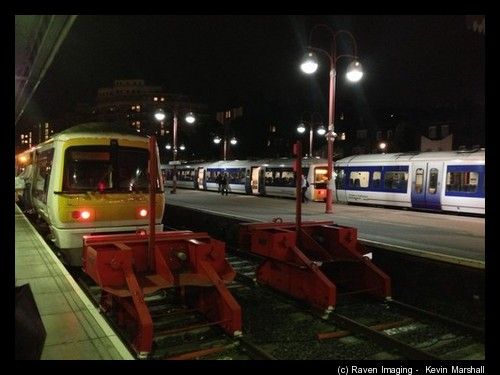
At Marylebone
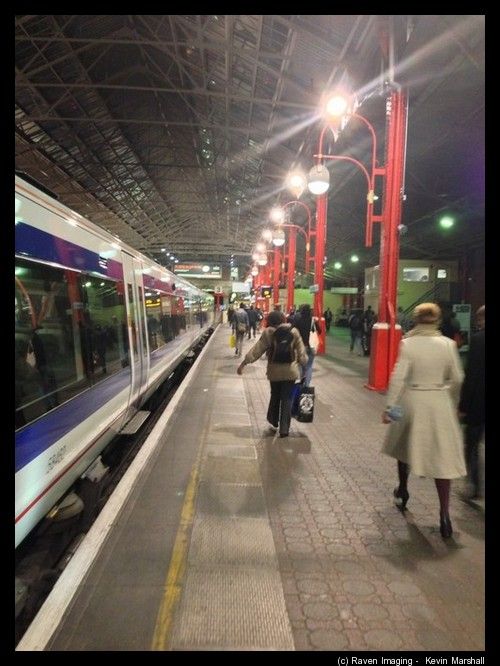
Heading to the barrier
I ambled my way off the train and through the ticket barrier. The next stop was to top off my Oyster Card. A quick beep, and it was a hop down the tube to Baker Street (yes, I could had walked the distance... but no...), then across the platform to the Jubilee Line all the way through the city, the south bank, until it popped up at the surface at Canning Town.

Tube rushing into the station
Up the stairs and over to the DLR platform, and finally to Prince Regent (don't get off at Customs House for ExCeL - you'd be walking for a fair bit). Remembering to touch out, it was then a case of down the stairs and well, aLoft stood out quite easily...

Believe it or not - I can actually shoot a hotel in the daylight.
aLoft Hotel, ExCeL West
Starwood Group.
After working my way in through the back entrance (going to the front would had been a longer hike), I headed to reception.
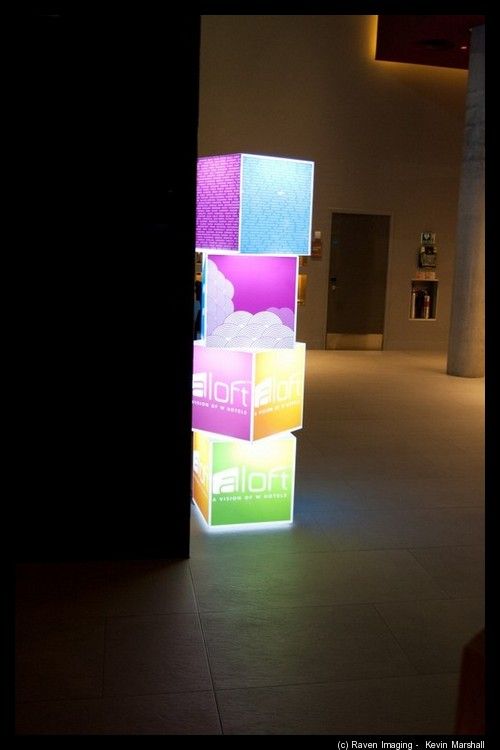
Cubes
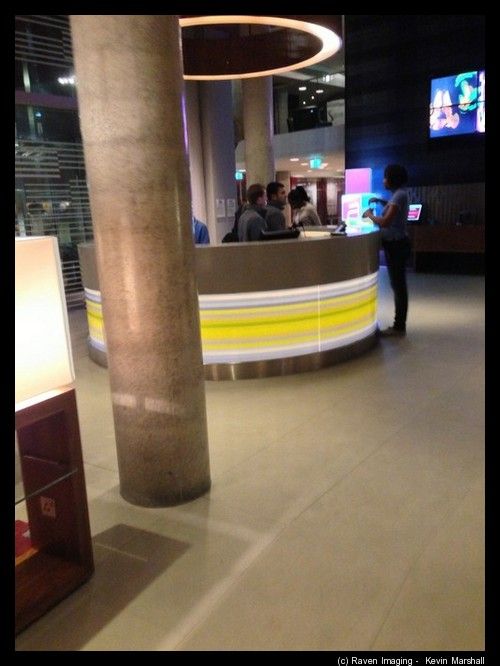
Reception
Now, I'm used to comparatively sombre and non-hip hotels. Well aLoft lived up to its "Hip" attitude that it promotes so much. And reception looks nice enough, with a bar area, little shop, and check-in. I checked in and informed reception of a package that was due to arrive the next day (there was a pre-trip accident... thankfully a company offered to help).
And the area does look hip, and seemly busy with people wandering in and out of the place. My priority was to get some rest before the 4:30 start that was to hit me.
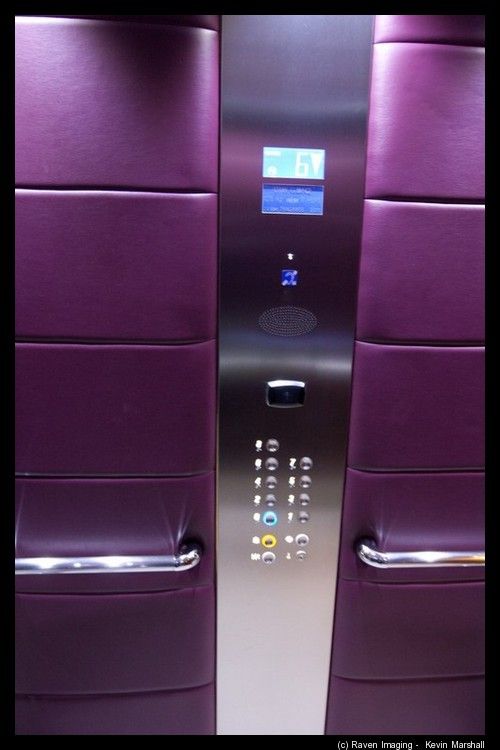
Padded lift.
Going up to the 6th floor, I was greeted with more "hipness"
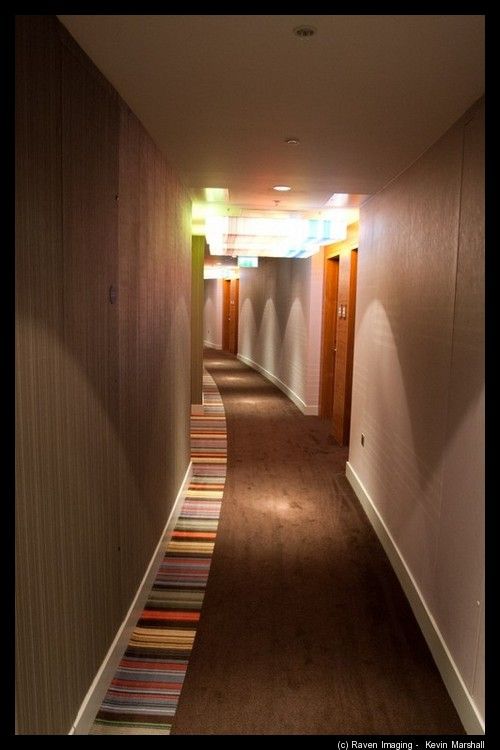
Heading to the room, the door was an electronic RFID style lock - ie wave it at the door, it unlocks.
The room itself wasn't massive per say, but was adequately sized

Bed

TV, work desk and sofa-thing.
The room itself was not a bad size for London, and it was fresh and up to date with an easy enough to control thermostat. The TV system was easy enough to use (especially since the new series of Red Dwarf had just started and I wanted to catch up with that)
Moving onto the bed - it was comfortable and was of a reasonable firmness - which was the core priority of the night. The bed was more than large enough for me, without feeling lost in it.
The desk had some useful connectivity - including wall mounted USB sockets, VGA, component video.

Media port, network connectivity and Keyboard Remote
Although if I was semi-local or a visitor, I'd think twice about using the telephone at the hotel...
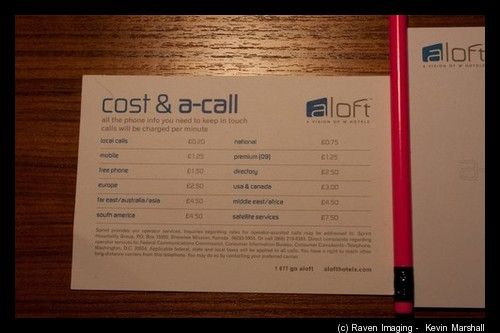
Hotel charges for telephone - note the cost of mobile charges, national charges, freephone charges and... well.. any telephone charge. To be honest, you could head a phone shop, buy a phone with credit for �20 and still come out on tops after a few days for using the telephone - or use Skype.
WiFi was provided free through the hotel. It was semi-protected, requiring a room number, surname and firstname to unlock it. WiFi speed was acceptable, and the download speed seemed quite acceptable.
Lets move onto the bathroom/shower area. The amenities were provided by Bliss, and were of good quality, with a large sink and shower.
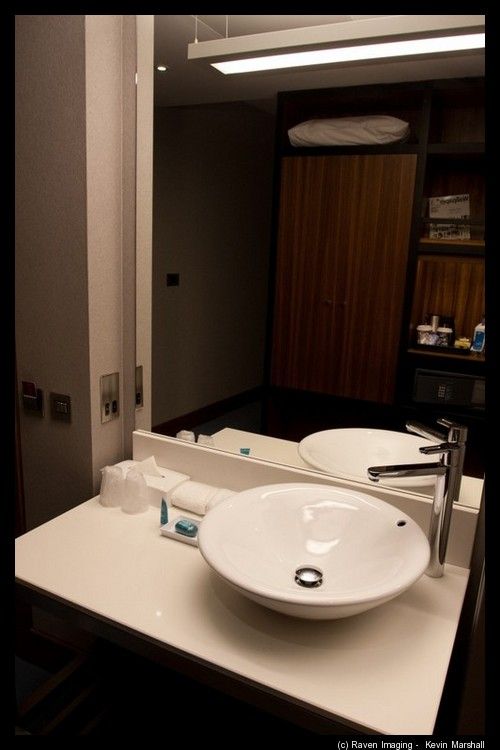
Wash basin

Bliss bar and body lotion
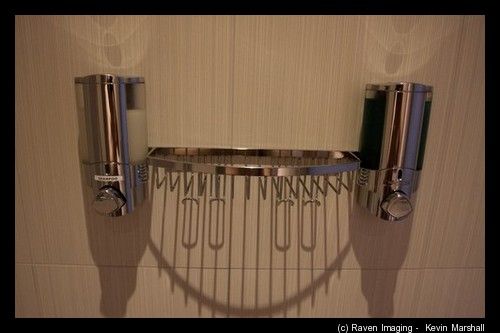
Shower products - note the Premier Inn style big tanks of shampoo/showergel
But alas, it is slightly disappointing - now I know we live in an eco-age but, aLoft is meant to be a high end-ish boutique hotel brand to mirror its W Hotel component... but bulk shampoo and shower gel doesn't strike me as premium at all really.
Tea and coffee was provided as well as two bottles of water - again, all welcome (especially the water - its the little things when you're running around)
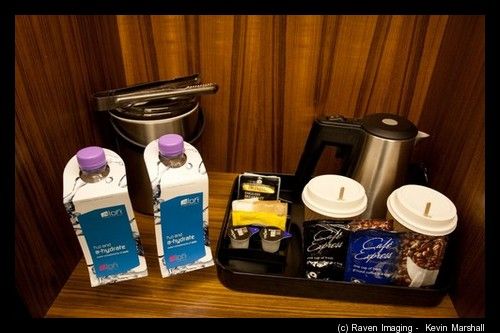
Drinks station.
Going back down in daylight, and you can see how they have laid out the bar
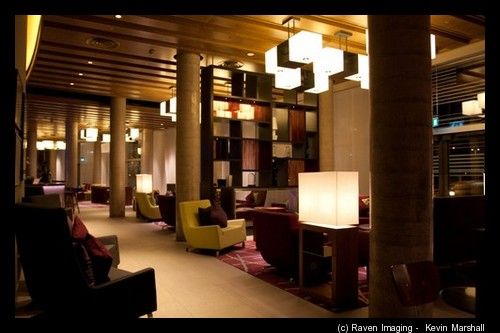
Lounge area
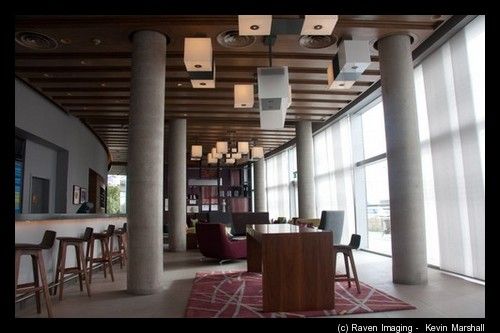
Bar area
After a restful nights sleep it was time to wake up as all the alarms were kicking off. By 5am, I was downstairs and in a cab to London City Airport - just over the water from the hotel.
Overall: It's a nice enough hotel, with plenty of features for the modern traveller who needs to be connected, and it scores well on these things. However, I still have trouble getting my mind off the big dispensers of shampoo and shower gel - it does cheapen the experience a tiny bit. Still, it's a good hotel for the location near ExCeL and London City Airport
Which is why I chose the Chiltern lines over the West Coast main line. Even though this is a "peak" service, there is no such thing as an "evening peak fare" from Birmingham - which means one can purchase the cheapest train ticket.
Even though I departed office on schedule in what should be no surprise to anyone, I missed my target train thanks to Birmingham traffic. This is why I try and buy unrestricted tickets normally.
Thankfully, it gave me some time to get some nibbles before travelling and to get to Moor Street station without rushing. It was then a case of picking up the tickets, heading through the inspection barrier and over to platform 1 for the train

Waiting for the train...
Chiltern Clubman Mainline Service,
Birmingham Moor Street to London Marylebone
Price paid: �27.50 Super Off Peak Return
Oh, I've written about this service plenty of times... But let's write more about it anyway

I brought a cheap �27.50 ticket that has odd conditions attached to it - namely you can't leave Birmingham before 11:00, and can't return from London between 16:30 and 19:30.
These tickers work well for the budget traveller as they are still "walk up" tickets as opposed to advance purchase which locks you into fixed trains only.
The service was operated by a Class 168 unit - not the last word in modern trains, but a still comfortable enough ride. The service was running a bit late due to a late start, but hey - peak hour trains on time? That's an odd enough concept.
The service was a stopper/commuter shuttle service, discharging most of its passenger at Solihull and then the local stations between Dorridge and Leamington spa. As a result, the further one got away from Birmingham, the more space opened up on the train.
WiFi as usual was offered free of charge as usual - a nice feature that makes Chiltern yet another reason to select over Virgin Trains - in fact the only Virgin has over Chiltern is speed to London. with the evening services taking up to 2 hours vs the fast trains of Virgin taking 1h 20 - but at �41 for a cheaper ticket verses Chiltern ... How much do you value 40 minutes in the evening?
As I said, the train was a bit late - no more than 5 minutes by the time the it had hit High Wycombe. After this point - the driver drove like a man possessed all the way to Marylebone - with the train making it there on time.

At Marylebone

Heading to the barrier
I ambled my way off the train and through the ticket barrier. The next stop was to top off my Oyster Card. A quick beep, and it was a hop down the tube to Baker Street (yes, I could had walked the distance... but no...), then across the platform to the Jubilee Line all the way through the city, the south bank, until it popped up at the surface at Canning Town.

Tube rushing into the station
Up the stairs and over to the DLR platform, and finally to Prince Regent (don't get off at Customs House for ExCeL - you'd be walking for a fair bit). Remembering to touch out, it was then a case of down the stairs and well, aLoft stood out quite easily...

Believe it or not - I can actually shoot a hotel in the daylight.
aLoft Hotel, ExCeL West
Starwood Group.
After working my way in through the back entrance (going to the front would had been a longer hike), I headed to reception.

Cubes

Reception
Now, I'm used to comparatively sombre and non-hip hotels. Well aLoft lived up to its "Hip" attitude that it promotes so much. And reception looks nice enough, with a bar area, little shop, and check-in. I checked in and informed reception of a package that was due to arrive the next day (there was a pre-trip accident... thankfully a company offered to help).
And the area does look hip, and seemly busy with people wandering in and out of the place. My priority was to get some rest before the 4:30 start that was to hit me.

Padded lift.
Going up to the 6th floor, I was greeted with more "hipness"

Heading to the room, the door was an electronic RFID style lock - ie wave it at the door, it unlocks.
The room itself wasn't massive per say, but was adequately sized

Bed

TV, work desk and sofa-thing.
The room itself was not a bad size for London, and it was fresh and up to date with an easy enough to control thermostat. The TV system was easy enough to use (especially since the new series of Red Dwarf had just started and I wanted to catch up with that)
Moving onto the bed - it was comfortable and was of a reasonable firmness - which was the core priority of the night. The bed was more than large enough for me, without feeling lost in it.
The desk had some useful connectivity - including wall mounted USB sockets, VGA, component video.

Media port, network connectivity and Keyboard Remote
Although if I was semi-local or a visitor, I'd think twice about using the telephone at the hotel...

Hotel charges for telephone - note the cost of mobile charges, national charges, freephone charges and... well.. any telephone charge. To be honest, you could head a phone shop, buy a phone with credit for �20 and still come out on tops after a few days for using the telephone - or use Skype.
WiFi was provided free through the hotel. It was semi-protected, requiring a room number, surname and firstname to unlock it. WiFi speed was acceptable, and the download speed seemed quite acceptable.
Lets move onto the bathroom/shower area. The amenities were provided by Bliss, and were of good quality, with a large sink and shower.

Wash basin

Bliss bar and body lotion

Shower products - note the Premier Inn style big tanks of shampoo/showergel
But alas, it is slightly disappointing - now I know we live in an eco-age but, aLoft is meant to be a high end-ish boutique hotel brand to mirror its W Hotel component... but bulk shampoo and shower gel doesn't strike me as premium at all really.
Tea and coffee was provided as well as two bottles of water - again, all welcome (especially the water - its the little things when you're running around)

Drinks station.
Going back down in daylight, and you can see how they have laid out the bar

Lounge area

Bar area
After a restful nights sleep it was time to wake up as all the alarms were kicking off. By 5am, I was downstairs and in a cab to London City Airport - just over the water from the hotel.
Overall: It's a nice enough hotel, with plenty of features for the modern traveller who needs to be connected, and it scores well on these things. However, I still have trouble getting my mind off the big dispensers of shampoo and shower gel - it does cheapen the experience a tiny bit. Still, it's a good hotel for the location near ExCeL and London City Airport
#3
Just before 05:15 I rocked up at the terminal entrance and made my way in. I declared myself - and one of the two hosts of the day welcome me to the airport.
I was then given an overview of the operation and the check-in area - seeing the support for airlines at London City is growing. They also mentioned a little timesaver for those travellers who have items to check in - the option to self tag bags. After this, it was time to head through Staff and Crew Security (through the most nondescript door), and after completing the usual aviation security, my escort and I were cleared to proceed.
We checked in with the Operations Team where I was greeted, and given an overview of what operations do for the airport - from checking runway lights are all working, to giving the go order open or shut the airport, to reporting on conditions on the tarmac. Which for the day of my visit - was soaking wet.

The truck waiting to take us on inspection
For the first part of the check, we needed to go off site to inspect the Instrument Landing System Lights (ILS) to check all the lights were functional. For LCY, this means taking a truck out into the local area, and inspecting ILS from local bridges.
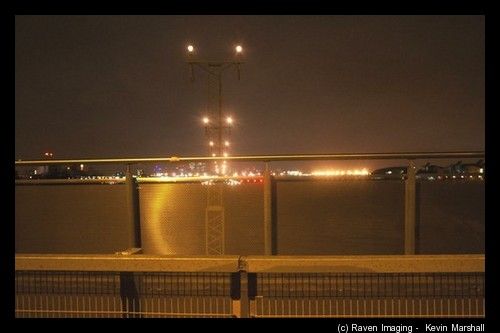
Looking towards 09 (Towards Canary Wharf)
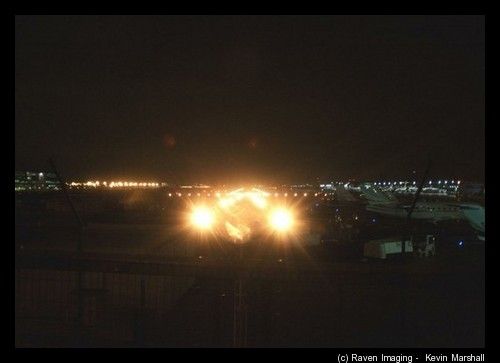
Looking towards 27 (Towards the JetCentre at London City Airport)
London City has one physical runway, but two approaches and departure points (like most runways). Departing from/Landing on Runway 27 heads towards Canary Wharf, whilst departing/arriving on Runway 9 heads towards the Thames.
This can be fun when boats decide to exit moorings and close bridges, but the ops inspector was in contact with tower to switch on and off the lights as needed, checking for blown bulbs.
Bulbs both on the ILS and on the Runway/Taxiways/turns are normally changed in the shut-down period LCY has every week - when the airport shuts to traffic from 12:30 on Saturday to 12:30 on Sunday. Emergency repairs can also be done if there are some major lighting failures - contributing to the safety factor.
Once the external checks were complete, it was time to re-enter airport premises. As there was traffic at the entrance to the airport (called the airlock for vehicles entering the secure side), my escort and I disembarked and re-cleared security.
Another member of the ops team met us to continue to the air-side check of broken bulbs, checking through the taxiways, and the runway itself driving up and down the full length of the runway.
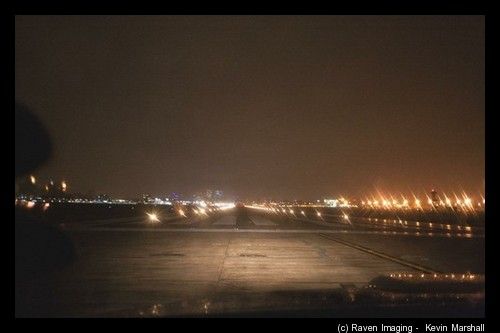
In the truck, looking down runway 27 towards Canary Wharf

Checking the runway makers are working near Alpha
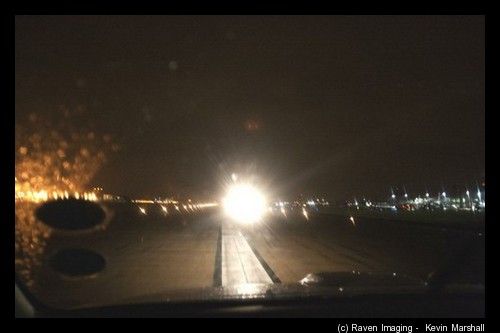
Even first thing in the morning, there's traffic on the runway - a fire service truck completing its sweep.
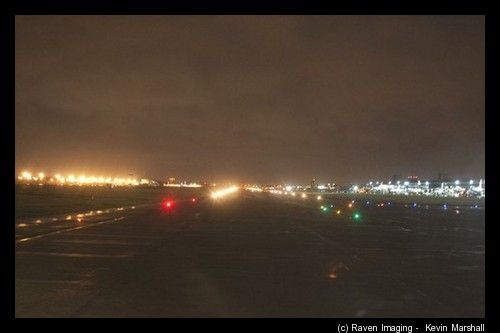
Looking up runway 9
The ops inspector was in constant contact, asking sections of lights to be switched off and on as needed, and noting which lights were dead - or not (for example one light was out on a Wigwam - an active runway light indicator - to which the response from control "Which is out - wig or wam" comes over the radio).
Whilst it was Friday, it was a professional discussion - and much like a family at work - that came over a lot during the visit.
After the runway inspection was passed (the first of four during the day), it was coming up on 06:25 local. This is the point where control of the runway is handed over from London City Airport Operations to NATS (National Air Traffic Services - or NATS Holdings), where the 1,500 meter concrete pavement turns from a piece of concrete to an active runway where planes are allowed to land. During the communication, conditions are also broadcast on the runway (on the day I was there - wet was the condition of the day).
Timing is critical at London City Airport as the airport has major restrictions in operational times due to noise:
Monday to Friday - 06:30 to 22:00
Saturday 06:30 to 12:30
Sunday 12:30 to 22:00
For the operations team, it's important to keep to those times as there is a risk of fines operating outside those hours, and the fact the first plane is due to push-back at 06:30 and the first arrival into the airport isn't far behind.
And as we pulled into towards JetCentre and Ramp operations, you can tell the pride the operations team have working there - and the consideration to safety needed to operate the airport professionally.
And that matters a lot.
--
After the inspection vehicle had dropped my escort and myself outside JetCentre, we headed up to Ramp control to shadow their operations for a while.
Ramp control as the name suggests controls activity on the ramp and apron of the airport, warning handling crews what time planes are due in, and where. And no matter the time of the day, it’s a busy place with lots of people managing a small airport.
Today, two people were managing the morning arrivals and morning departures rush, with another two handing reporting and planning.
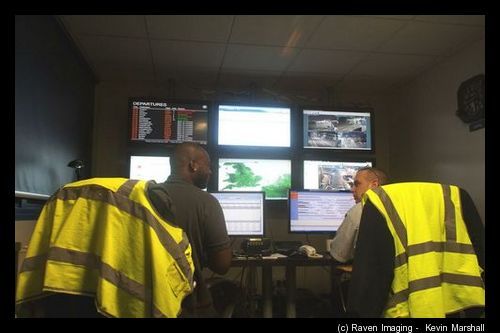
Conversing in a quiet moment
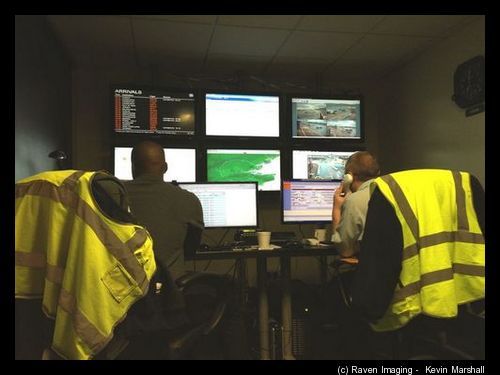
Answering a query on a plane that is staying a bit longer than intended
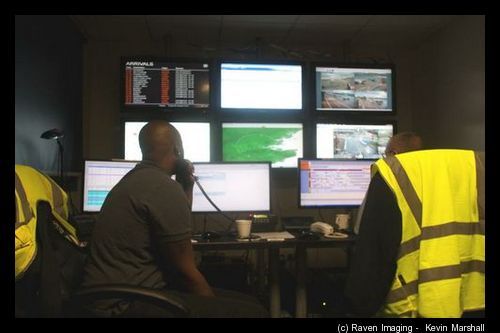
Talking to the ramp.
It’s the place that controls the buses and where the planes park.
So… a rather important spot.
The screens are rather interesting – but for a lot of us – the one with a map of the South East of England is the one that holds most interest. If you look at the screen carefully, you’ll see a ring drawn around it. Depending on the runway and how it is used it’s 10 minutes to the airport if on a river approach, 15 if coming from the rest of UK.
And in those 10 minutes, ramp workers need to be notified, and stands need to be confirmed – with confirmation at 10 minutes normally. Of course if there is a major rush, its a case of get the plane down and then get it to a stand.
There was some issues in the past of parking the bigger planes at the airport – especially since the Embraer 170/190′s are becoming very popular at the airport over the older AvroRJ/BAe-146 series. Thankfully the stands have been re-configured so that all but two stands can now cope with any regional aircraft (The British Airways A318′s that have to live at the apron near Gate 23/24).
Of course, planes don’t exactly always obey timings and irregular operations happen – that’s when this team re-plan and identify the changes that need to be made as needed.
There is a lot of dual working – and sometimes three person working when extra busy to handle radio and telephone communications.
Handling of arrivals, departures and what work needs to be done is managed from a constantly updated planning tool – and it allows for long range planning for 6 hours and beyond. However, there are things that come into play that can cause issues – for example the day I was there a NOTAM (Notice To Airmen) was issued that Strong winds were expected in the LCY area from 08:00 – this impacts on landings – and possible go-arounds too.
Other things that can impact are snow, Fog (an issue London City suffers due to it being slap bang in the middle of the Royal Albert Docks, and the River Thames to the side of it) and of course – bird strikes. Should systems go down (dread the thought), the operation can be split with staff pitching up at operations, whilst others are working ramp control at ops and working over radios till systems can be brought back up.
It’s a tough operation – but the team mange it with ease.
The ramp teams work in groups of 8-9 depending on the loads and the shifts to meet the deadlines that airline managers put on them to turn planes around – and as a lot of aircraft “pit stop” only at LCY, they need to make sure the right balance of people are assigned. For example:
- For an AvroRJ/BAe146, or a TurboProp 2 people can manage the load/unload and prep of the aircraft
- For an ERJ, becaue of the extra load of passengers and cargo they can hold, three people are needed.
- Lufthansa/Swiss CRJ’s have requirements where to place bags in the hold
The number of people also depends on the load and what cargo is handled – so constant replanning is needed to ensure a top quality service. It also allows the airport to bring in staff as needed in a controlled manner as opposed to just over-hiring people – allowing costs to be controlled.
It also allows the right people to be on-site too – so for example, more staff can be pulled in on the busy mornings on Monday and Tuesday, whilst reducing the need for people that are needed for Saturday morning.
That’s important because the costs that are spent at an airport have to be paid by an airline – which eventually goes into the price of the ticket we pay to fly.
There are challenges to the posts that are run by Ramp control – for example the constant repeating of information and sometimes the ramp workers wondering why things are done a certain way. Ramp Control are planning more “experience days” to share the knowledge and information that they do with the ramp workers – and show them the impact the decision made in control have on the ground, with the impact those decisions have.
And what an interesting challenge they have there, squeezing in the departures and arrivals, getting bags loaded and unloaded, fuelling planes, ensuring stands are available, if buses are needed and where to make them accessible.
---
As my escort and I left Ramp Control, we passed through JetCentre on the way through.
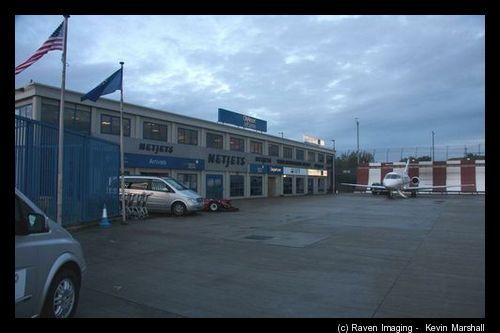
JetCentre as the name suggests is where the corporate jets and fractional operators (such as NetJets) are based. This area lies to the West of the airport near (beyond Gate 1 towards Canary Wharf and the City).
And London City can handle a fair few types:
- BE20 Beechcraft 200
- BE9L Beechcraft 900
- BE58 PA Beechcraft Baron B300 Beechcraft
- Beech 400 XP
- Hawker 800 XP
- C510 (Citation Mustang)
- C550 (Citation II)
- C560 (Citation V)
- C525 CJ1 (Citation Jet 1)
- C525 CJ2 (Citation Jet 2)
- C525 CJ3 (Citation Jet 3)
- C550 (Citation Bravo)
- C56X (Citation Excel)
- C680 (Citation Soverign)
- EMB 135BJ (Legacy)
- FA10 (Falcon 10
- FA50 (Falcon 50)
- F7X (Falcon 7X)
- F900EX (Falcon 900EX)
- F200 EX/LX (Dassault Falcon 2000 EX/LX)
- Bombardier Challenger 605 (CL60)
- Learjet 45 (LJ45)
- P180 (Piaggio Avanti)
- G150 (Gulfstream 150)
Whilst there is a great variation in that list, that covers anything from a short range prop (such as the P180 to a tri-engined business jet that is Trans-Atlantic capable (Dassault Falcon F7X - subject to payload, fuel and runway length) - a great range of aircraft
The base has the full facilities needed for handling, catering, immigration and supports a full crew setup and briefing too so everything can be contained on-site and in one building - allowing a quick in and out that those corporate jet fliers demand.
Now, you'll have to forgive my plane spotting spotting abilities. Big commercial stuff from a CRJ up to an A380 I can spot without a hint of trouble - Corporate Jets are a bit more difficult!
When I left the JetCentre, there were 5 private jets parked - 4 overnight and 1 that had just arrived.
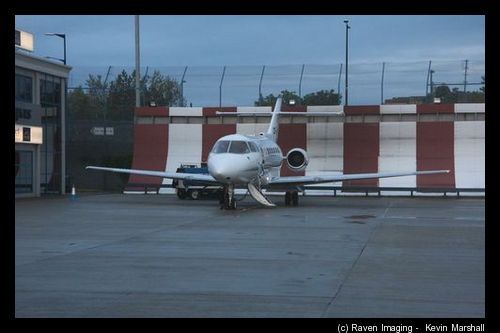

The recent arrival and the ramp crew inspecting as needed
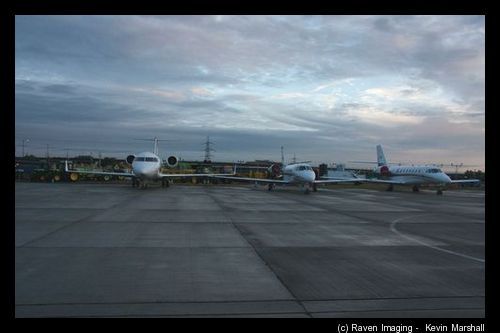
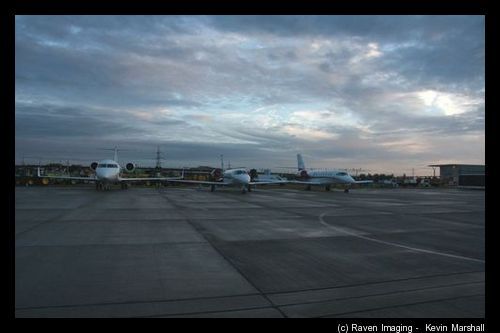
Three private jets in a row parked up at the JetCentre
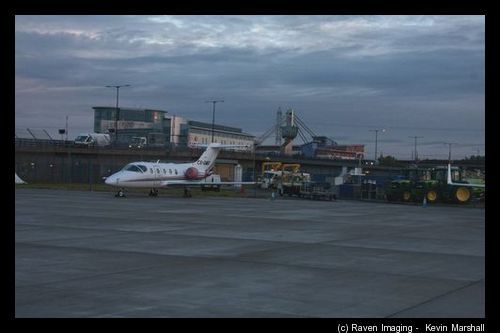
One more in a corner - note the equipment behind it.
Also stored at this end of the airport is the Winter Equipment (Snow Clearing) and the Fire Service Practice Rig (that Miles from Blighty wrote about on his visit). Whilst London City Airport suffers from fog and low visibility, keeping the runway and airport open during snow doesn't appear to be a problem for them due to the time it takes to clear the snow, and how quick they can open the runway again.
Being prepared for anything strikes me as one of the things I'll take away from visiting LCY - from ground, terminal, corporate and commercial aviation - a great way to run an airport.
Next - Ramp Walks!
I was then given an overview of the operation and the check-in area - seeing the support for airlines at London City is growing. They also mentioned a little timesaver for those travellers who have items to check in - the option to self tag bags. After this, it was time to head through Staff and Crew Security (through the most nondescript door), and after completing the usual aviation security, my escort and I were cleared to proceed.
We checked in with the Operations Team where I was greeted, and given an overview of what operations do for the airport - from checking runway lights are all working, to giving the go order open or shut the airport, to reporting on conditions on the tarmac. Which for the day of my visit - was soaking wet.

The truck waiting to take us on inspection
For the first part of the check, we needed to go off site to inspect the Instrument Landing System Lights (ILS) to check all the lights were functional. For LCY, this means taking a truck out into the local area, and inspecting ILS from local bridges.

Looking towards 09 (Towards Canary Wharf)

Looking towards 27 (Towards the JetCentre at London City Airport)
London City has one physical runway, but two approaches and departure points (like most runways). Departing from/Landing on Runway 27 heads towards Canary Wharf, whilst departing/arriving on Runway 9 heads towards the Thames.
This can be fun when boats decide to exit moorings and close bridges, but the ops inspector was in contact with tower to switch on and off the lights as needed, checking for blown bulbs.
Bulbs both on the ILS and on the Runway/Taxiways/turns are normally changed in the shut-down period LCY has every week - when the airport shuts to traffic from 12:30 on Saturday to 12:30 on Sunday. Emergency repairs can also be done if there are some major lighting failures - contributing to the safety factor.
Once the external checks were complete, it was time to re-enter airport premises. As there was traffic at the entrance to the airport (called the airlock for vehicles entering the secure side), my escort and I disembarked and re-cleared security.
Another member of the ops team met us to continue to the air-side check of broken bulbs, checking through the taxiways, and the runway itself driving up and down the full length of the runway.

In the truck, looking down runway 27 towards Canary Wharf

Checking the runway makers are working near Alpha

Even first thing in the morning, there's traffic on the runway - a fire service truck completing its sweep.

Looking up runway 9
The ops inspector was in constant contact, asking sections of lights to be switched off and on as needed, and noting which lights were dead - or not (for example one light was out on a Wigwam - an active runway light indicator - to which the response from control "Which is out - wig or wam" comes over the radio).
Whilst it was Friday, it was a professional discussion - and much like a family at work - that came over a lot during the visit.
After the runway inspection was passed (the first of four during the day), it was coming up on 06:25 local. This is the point where control of the runway is handed over from London City Airport Operations to NATS (National Air Traffic Services - or NATS Holdings), where the 1,500 meter concrete pavement turns from a piece of concrete to an active runway where planes are allowed to land. During the communication, conditions are also broadcast on the runway (on the day I was there - wet was the condition of the day).
Timing is critical at London City Airport as the airport has major restrictions in operational times due to noise:
Monday to Friday - 06:30 to 22:00
Saturday 06:30 to 12:30
Sunday 12:30 to 22:00
For the operations team, it's important to keep to those times as there is a risk of fines operating outside those hours, and the fact the first plane is due to push-back at 06:30 and the first arrival into the airport isn't far behind.
And as we pulled into towards JetCentre and Ramp operations, you can tell the pride the operations team have working there - and the consideration to safety needed to operate the airport professionally.
And that matters a lot.
--
After the inspection vehicle had dropped my escort and myself outside JetCentre, we headed up to Ramp control to shadow their operations for a while.
Ramp control as the name suggests controls activity on the ramp and apron of the airport, warning handling crews what time planes are due in, and where. And no matter the time of the day, it’s a busy place with lots of people managing a small airport.
Today, two people were managing the morning arrivals and morning departures rush, with another two handing reporting and planning.

Conversing in a quiet moment

Answering a query on a plane that is staying a bit longer than intended

Talking to the ramp.
It’s the place that controls the buses and where the planes park.
So… a rather important spot.
The screens are rather interesting – but for a lot of us – the one with a map of the South East of England is the one that holds most interest. If you look at the screen carefully, you’ll see a ring drawn around it. Depending on the runway and how it is used it’s 10 minutes to the airport if on a river approach, 15 if coming from the rest of UK.
And in those 10 minutes, ramp workers need to be notified, and stands need to be confirmed – with confirmation at 10 minutes normally. Of course if there is a major rush, its a case of get the plane down and then get it to a stand.
There was some issues in the past of parking the bigger planes at the airport – especially since the Embraer 170/190′s are becoming very popular at the airport over the older AvroRJ/BAe-146 series. Thankfully the stands have been re-configured so that all but two stands can now cope with any regional aircraft (The British Airways A318′s that have to live at the apron near Gate 23/24).
Of course, planes don’t exactly always obey timings and irregular operations happen – that’s when this team re-plan and identify the changes that need to be made as needed.
There is a lot of dual working – and sometimes three person working when extra busy to handle radio and telephone communications.
Handling of arrivals, departures and what work needs to be done is managed from a constantly updated planning tool – and it allows for long range planning for 6 hours and beyond. However, there are things that come into play that can cause issues – for example the day I was there a NOTAM (Notice To Airmen) was issued that Strong winds were expected in the LCY area from 08:00 – this impacts on landings – and possible go-arounds too.
Other things that can impact are snow, Fog (an issue London City suffers due to it being slap bang in the middle of the Royal Albert Docks, and the River Thames to the side of it) and of course – bird strikes. Should systems go down (dread the thought), the operation can be split with staff pitching up at operations, whilst others are working ramp control at ops and working over radios till systems can be brought back up.
It’s a tough operation – but the team mange it with ease.
The ramp teams work in groups of 8-9 depending on the loads and the shifts to meet the deadlines that airline managers put on them to turn planes around – and as a lot of aircraft “pit stop” only at LCY, they need to make sure the right balance of people are assigned. For example:
- For an AvroRJ/BAe146, or a TurboProp 2 people can manage the load/unload and prep of the aircraft
- For an ERJ, becaue of the extra load of passengers and cargo they can hold, three people are needed.
- Lufthansa/Swiss CRJ’s have requirements where to place bags in the hold
The number of people also depends on the load and what cargo is handled – so constant replanning is needed to ensure a top quality service. It also allows the airport to bring in staff as needed in a controlled manner as opposed to just over-hiring people – allowing costs to be controlled.
It also allows the right people to be on-site too – so for example, more staff can be pulled in on the busy mornings on Monday and Tuesday, whilst reducing the need for people that are needed for Saturday morning.
That’s important because the costs that are spent at an airport have to be paid by an airline – which eventually goes into the price of the ticket we pay to fly.
There are challenges to the posts that are run by Ramp control – for example the constant repeating of information and sometimes the ramp workers wondering why things are done a certain way. Ramp Control are planning more “experience days” to share the knowledge and information that they do with the ramp workers – and show them the impact the decision made in control have on the ground, with the impact those decisions have.
And what an interesting challenge they have there, squeezing in the departures and arrivals, getting bags loaded and unloaded, fuelling planes, ensuring stands are available, if buses are needed and where to make them accessible.
---
As my escort and I left Ramp Control, we passed through JetCentre on the way through.

JetCentre as the name suggests is where the corporate jets and fractional operators (such as NetJets) are based. This area lies to the West of the airport near (beyond Gate 1 towards Canary Wharf and the City).
And London City can handle a fair few types:
- BE20 Beechcraft 200
- BE9L Beechcraft 900
- BE58 PA Beechcraft Baron B300 Beechcraft
- Beech 400 XP
- Hawker 800 XP
- C510 (Citation Mustang)
- C550 (Citation II)
- C560 (Citation V)
- C525 CJ1 (Citation Jet 1)
- C525 CJ2 (Citation Jet 2)
- C525 CJ3 (Citation Jet 3)
- C550 (Citation Bravo)
- C56X (Citation Excel)
- C680 (Citation Soverign)
- EMB 135BJ (Legacy)
- FA10 (Falcon 10
- FA50 (Falcon 50)
- F7X (Falcon 7X)
- F900EX (Falcon 900EX)
- F200 EX/LX (Dassault Falcon 2000 EX/LX)
- Bombardier Challenger 605 (CL60)
- Learjet 45 (LJ45)
- P180 (Piaggio Avanti)
- G150 (Gulfstream 150)
Whilst there is a great variation in that list, that covers anything from a short range prop (such as the P180 to a tri-engined business jet that is Trans-Atlantic capable (Dassault Falcon F7X - subject to payload, fuel and runway length) - a great range of aircraft
The base has the full facilities needed for handling, catering, immigration and supports a full crew setup and briefing too so everything can be contained on-site and in one building - allowing a quick in and out that those corporate jet fliers demand.
Now, you'll have to forgive my plane spotting spotting abilities. Big commercial stuff from a CRJ up to an A380 I can spot without a hint of trouble - Corporate Jets are a bit more difficult!
When I left the JetCentre, there were 5 private jets parked - 4 overnight and 1 that had just arrived.


The recent arrival and the ramp crew inspecting as needed


Three private jets in a row parked up at the JetCentre

One more in a corner - note the equipment behind it.
Also stored at this end of the airport is the Winter Equipment (Snow Clearing) and the Fire Service Practice Rig (that Miles from Blighty wrote about on his visit). Whilst London City Airport suffers from fog and low visibility, keeping the runway and airport open during snow doesn't appear to be a problem for them due to the time it takes to clear the snow, and how quick they can open the runway again.
Being prepared for anything strikes me as one of the things I'll take away from visiting LCY - from ground, terminal, corporate and commercial aviation - a great way to run an airport.
Next - Ramp Walks!
#4
Heading away from the JetCentre and back to the main terminal, it was a case of making sure that the high visibility jacket was done up right (safety is a prime concern at LCY, and making sure your hi-viz jacked is done up at all times is very important), and following the walkway markers back to the main terminal building.

Morning sunrise after the rain at LCY.
As the airport has now turned from an inactive field to an active walkway, it's important to stay within the designated walkways due to the busy traffic on stand and working the ramp/stands.
Passing through you see how busy the little airport is. Today seems like a good day for those who don't like to be bussed as the bus fleet is sitting in situ

The LCY bussing fleet - a total of 3 buses
As we crossed from the JetCentre to the main apron, a BA CityFlyer service was coming in.
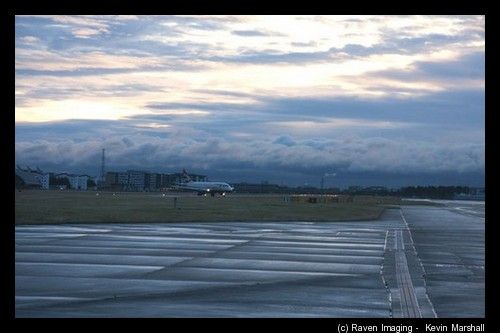


As you can see, space is tight first thing in the morning, so planes have to move with care and with guidance from the ground crew. Unlike most airports where planes dock at a hard stand facing the terminal, planes are guided in and turned whilst coming into their final position. This disposes the need of tugs for pushback purposes and creating faster turnaround times. The other reason - there's simply not the space to handle tugs.
Closing in on the terminal building, a CityJet (ex VLM) Fokker 50 was preparing for departure - you can see the ground equipment at work here
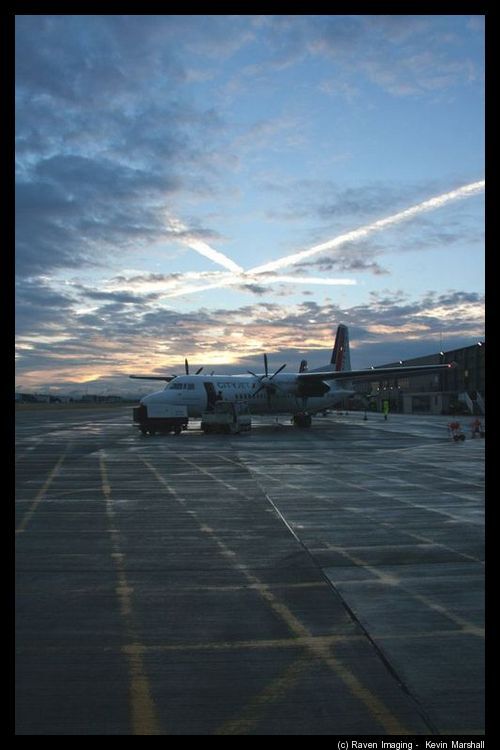
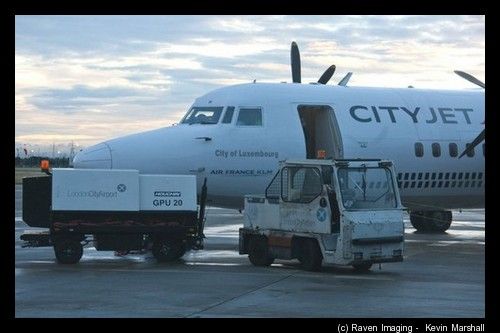
Ground power for the Fokker.

Final checks waiting for departure
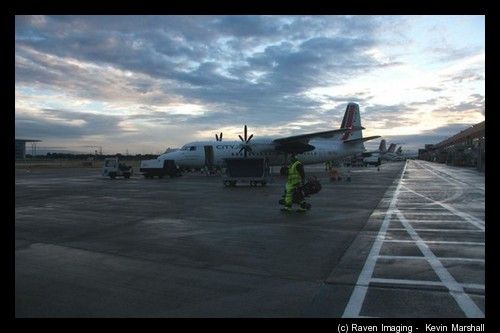
Loading buggies
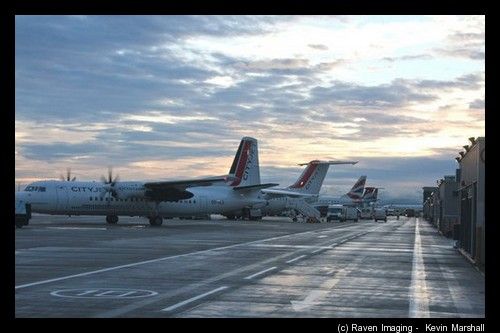
Props turning - ready to leave.
One of the most interesting experiences I had at LCY was when we had to re-enter the terminal and go through the international clearance section - passport control. By default I was heading to pull my passport out - but we kept walking through control.
Of course, I had forgot about the little guest identity card that was around my neck. Oops. But that was a first - going through passport control without a passport.
But that was a first - going through passport control without a passport.
Taking a magical side door (of which there are plenty in this airport), we exited into the main departure area, and my hosts set me down for breakfast at the City Bar and Grill.
To the side of us was some luggage as art...
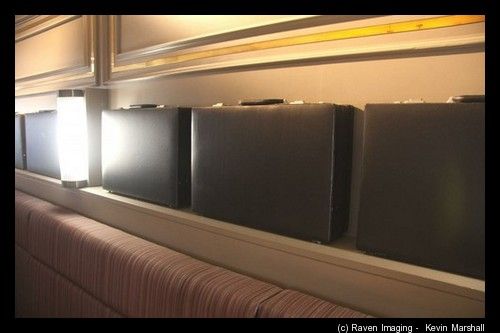
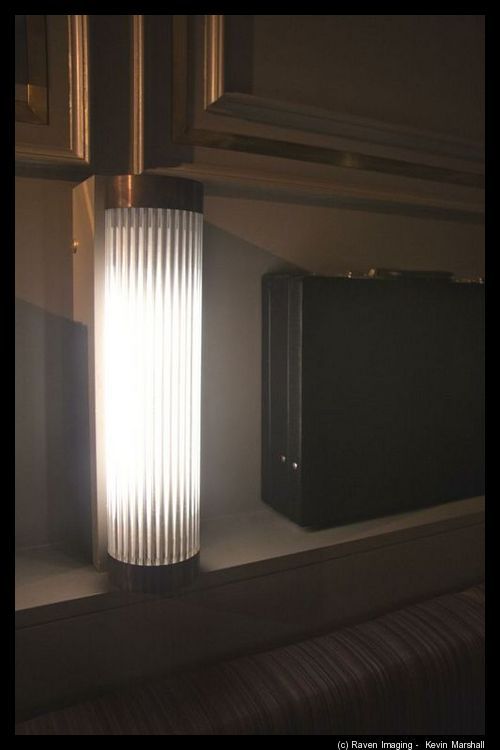
It's art. Don't question art
During breakfast one of the Communications Mangers from London City Airport joined my escort and myself where we talked about various subjects, and discussed the second part of the tour - a lot more of the detail of which I'll reveal...
... In part 2 of the ramp walk

Morning sunrise after the rain at LCY.
As the airport has now turned from an inactive field to an active walkway, it's important to stay within the designated walkways due to the busy traffic on stand and working the ramp/stands.
Passing through you see how busy the little airport is. Today seems like a good day for those who don't like to be bussed as the bus fleet is sitting in situ

The LCY bussing fleet - a total of 3 buses
As we crossed from the JetCentre to the main apron, a BA CityFlyer service was coming in.



As you can see, space is tight first thing in the morning, so planes have to move with care and with guidance from the ground crew. Unlike most airports where planes dock at a hard stand facing the terminal, planes are guided in and turned whilst coming into their final position. This disposes the need of tugs for pushback purposes and creating faster turnaround times. The other reason - there's simply not the space to handle tugs.
Closing in on the terminal building, a CityJet (ex VLM) Fokker 50 was preparing for departure - you can see the ground equipment at work here


Ground power for the Fokker.

Final checks waiting for departure

Loading buggies

Props turning - ready to leave.
One of the most interesting experiences I had at LCY was when we had to re-enter the terminal and go through the international clearance section - passport control. By default I was heading to pull my passport out - but we kept walking through control.
Of course, I had forgot about the little guest identity card that was around my neck. Oops.
 But that was a first - going through passport control without a passport.
But that was a first - going through passport control without a passport.Taking a magical side door (of which there are plenty in this airport), we exited into the main departure area, and my hosts set me down for breakfast at the City Bar and Grill.
To the side of us was some luggage as art...


It's art. Don't question art

During breakfast one of the Communications Mangers from London City Airport joined my escort and myself where we talked about various subjects, and discussed the second part of the tour - a lot more of the detail of which I'll reveal...
... In part 2 of the ramp walk

#5
After a great breakfast, it was time to continue the tour of the airport - with a walk down to Gate 23/24. Gate 23 is where the BA1/3 services depart. This end of the airport is the interesting bit too - as this is where the planned expansion of the airport will occur - as Gate 23/24 are over water and are built on stilts. To expand gates and extra space, expect more expansion from Gate 24 onwards in the future.
We dropped into Gate 23 - the British Airways Club World London City Airport departure gate.

Gate 23 Departure Lounge

Not flying today... but thank you!
Walking onto the ramp, G-EUNB was resting after its long leg from New York and was being serviced
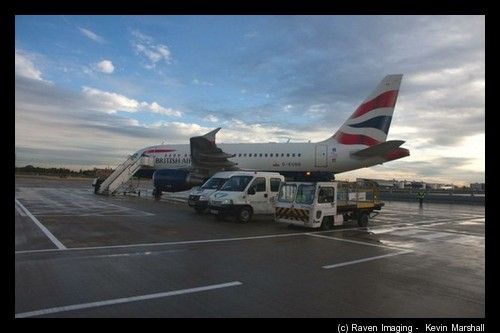
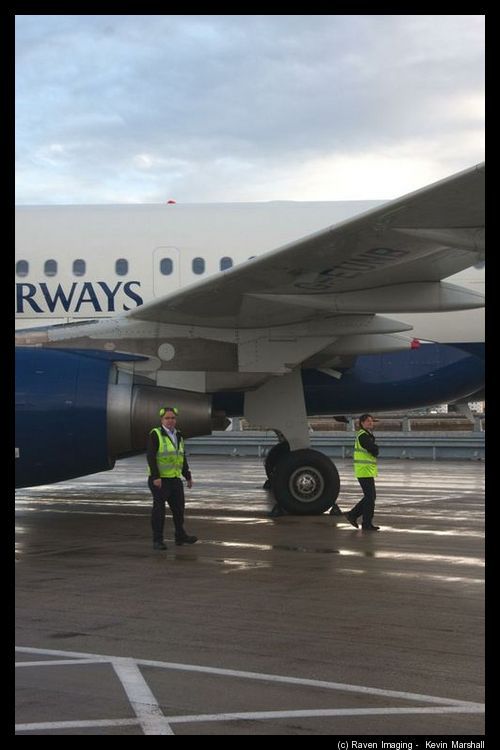
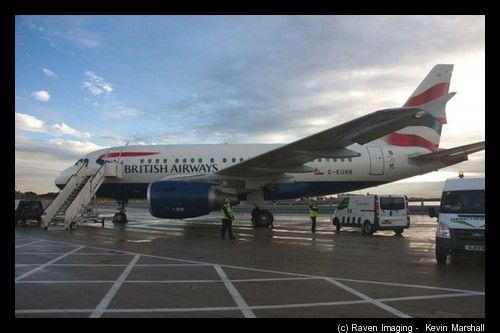
Ground crew checking G-EUNB out
Meanwhile, LCY arrivals and take offs were abound - this being the rush hour.
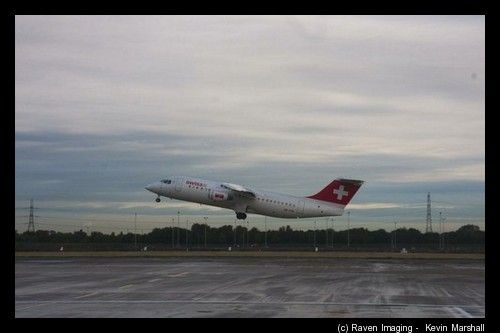
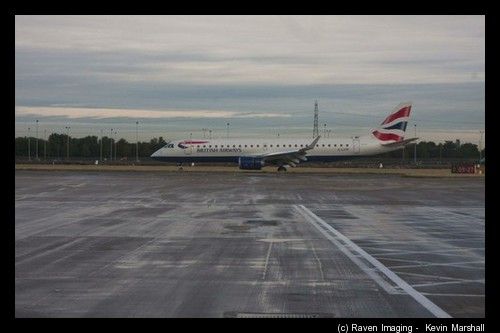
London City's major tenants are CityJet (by the number of flights) and BA CityFlyer (by passengers).
By airline alliance it's a slightly different picture with the following breakdown:
- 36% of Traffic is Oneworld traffic (through BA CityFlyer and SunAir for BA)
- 36% is SkyTeam traffic (through CityFlyer, Air France and Alitalia)
- 23% is Star Alliance Traffic (through Lufthansa and Swiss)
- 6% through other operators who are non aligned to a major alliance (Aer Arran, Blue Islands, Luxair and SkyWork)
Whilst the airport has no major maintenance facilities (for the very simple reason - a lack of space), it does allow night-stopping of aircraft so they are in position for the next day.
Checked luggage - although minimal to some hubs is still an important operation at London City Airport as it handles both checked bags and cargo consignments.
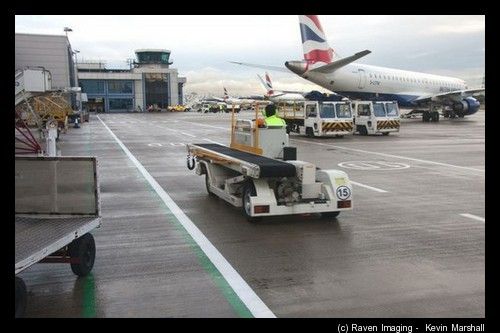
Luggage loading/unloaded moving belt... moving.
Luggage at City is much less complex affair, with a luggage going through the check-in belt, then through screening and then onto a reception belt where bags are sorted for flights in one hall. Bags are then consolidated by hand to match up with the manifests.
Luggage then goes out to the plane and consolidated again so numbers tally and matches the fuel estimates that the captain needs to get their plane to the destination.
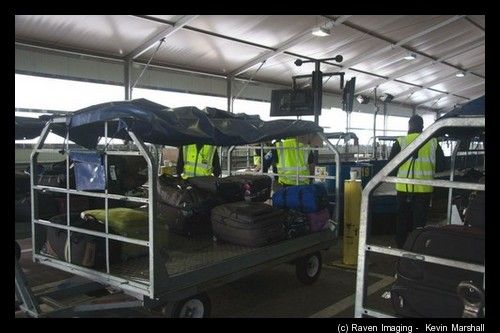
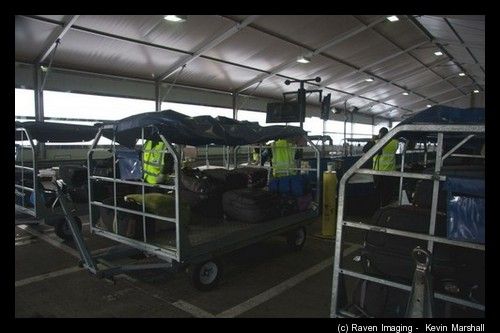

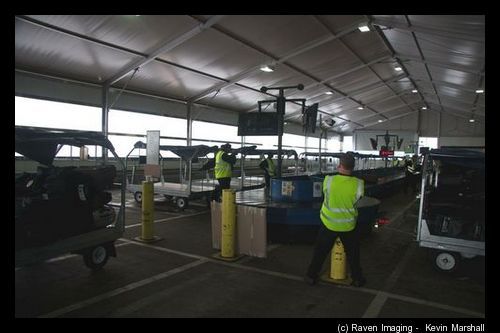
Whilst not a massive operation, it still is a hive of activity when the airport is active.
Coming up - How do you marshal a plane into a small stand? LCY Shows you how....
We dropped into Gate 23 - the British Airways Club World London City Airport departure gate.

Gate 23 Departure Lounge

Not flying today... but thank you!
Walking onto the ramp, G-EUNB was resting after its long leg from New York and was being serviced



Ground crew checking G-EUNB out
Meanwhile, LCY arrivals and take offs were abound - this being the rush hour.


London City's major tenants are CityJet (by the number of flights) and BA CityFlyer (by passengers).
By airline alliance it's a slightly different picture with the following breakdown:
- 36% of Traffic is Oneworld traffic (through BA CityFlyer and SunAir for BA)
- 36% is SkyTeam traffic (through CityFlyer, Air France and Alitalia)
- 23% is Star Alliance Traffic (through Lufthansa and Swiss)
- 6% through other operators who are non aligned to a major alliance (Aer Arran, Blue Islands, Luxair and SkyWork)
Whilst the airport has no major maintenance facilities (for the very simple reason - a lack of space), it does allow night-stopping of aircraft so they are in position for the next day.
Checked luggage - although minimal to some hubs is still an important operation at London City Airport as it handles both checked bags and cargo consignments.

Luggage loading/unloaded moving belt... moving.
Luggage at City is much less complex affair, with a luggage going through the check-in belt, then through screening and then onto a reception belt where bags are sorted for flights in one hall. Bags are then consolidated by hand to match up with the manifests.
Luggage then goes out to the plane and consolidated again so numbers tally and matches the fuel estimates that the captain needs to get their plane to the destination.




Whilst not a massive operation, it still is a hive of activity when the airport is active.
Coming up - How do you marshal a plane into a small stand? LCY Shows you how....
#6
As we exited the luggage area, a BA CityFlyer E190 was coming in to its stand - and if you never seen the actitvity that goes on when a plane comes into land at this airport its an interesting sight.
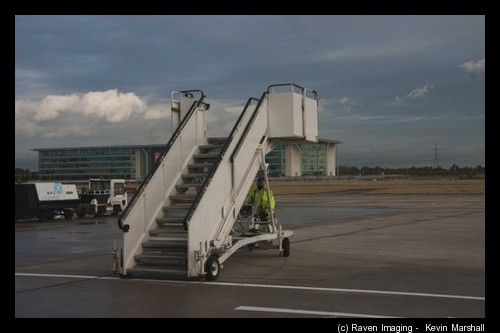
Firstly Ground Crews, Ground Power and other departments are ready to handle the arrival
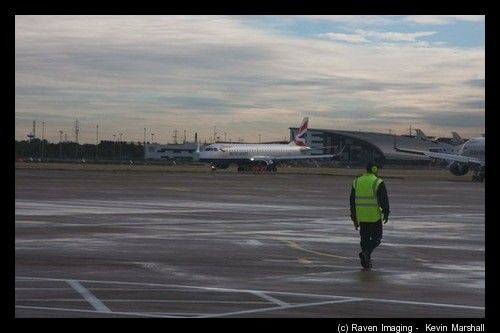
The inbound E-170 coming in
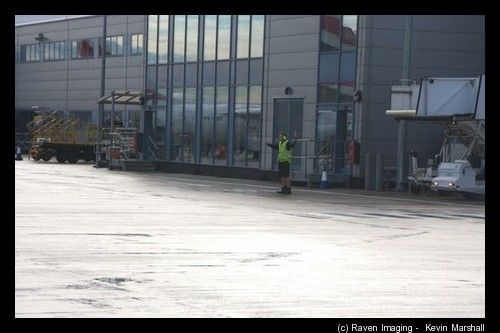
The plane is guided in the old fashioned way - two battons and brave person marshalling in the plane to the stand area.
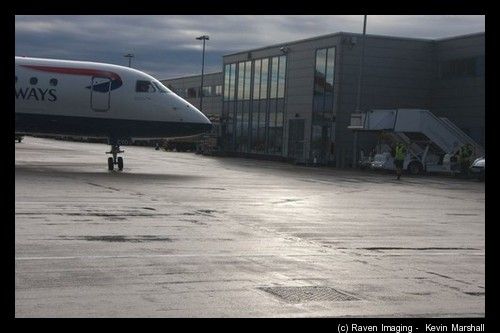
As the plane comes in closer towards the terminal building, the plane must turn. Here, the marshal is directing the plane to turn right and come around.
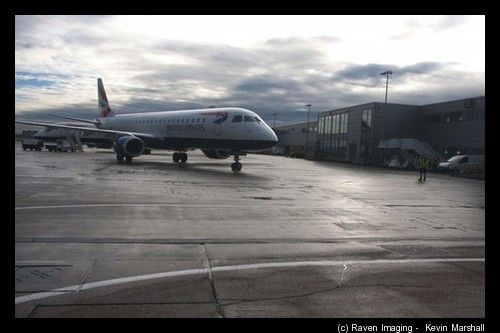
The plane is turning still under the marshal's instructions.
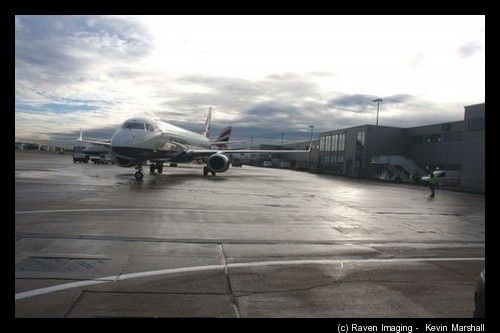
The plane is now almost turned, with 90dregrees or so of turn to go.
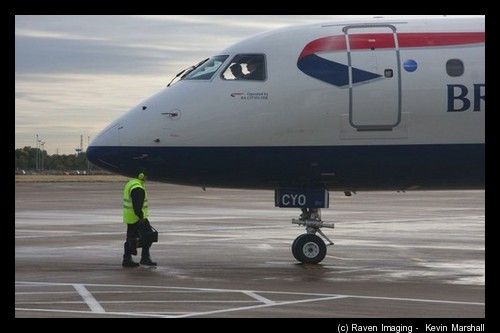
The plane now turned, and set for its departure point and now "on stand" can now power down be chocked. The chocks now go on the forward gear.

With the first set of chocks going on, the ground team goes into action, docking steps and preparing to accept the passengers aboard the flight.
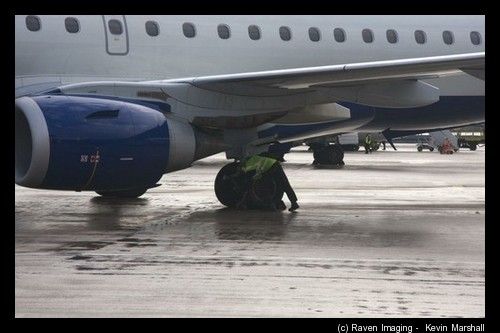
The second set of chocks go on, and the rest of the crews move in to service the aircraft on a tight turnaround. Soon enough this E-Jet will take to the skies again.
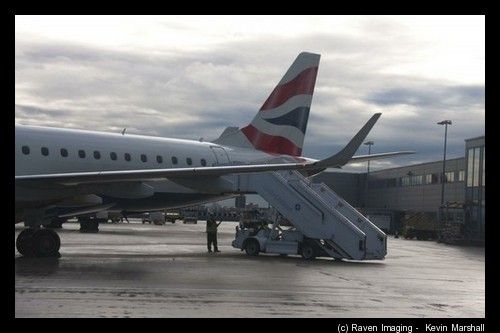
The rear set of steps is attached to allow faster unloading. The plane is now almost ready to unload its passengers.
When watching the operation, you know its got to be tight and quick to turn planes around quickly, and to see it in action is like an organised ballet - and gives an insight into the operations that are needed to turn around a plane at this airport.
The airport has had some interesting wins recently in terms of traffic, with Alitaila coming to London City. In addition, Estonian Air is a major win for London City (as the airline is switching from 737's and CRJ's to an E-190 platform). Route development is an important subject for an airport that operates 44 routes, and there is always scope to add more services - alas peak time services may be slightly problematic due to the lack of stands at peak hours.
Still, if the expansion goes ahead, this can only be good for this airport.

Firstly Ground Crews, Ground Power and other departments are ready to handle the arrival

The inbound E-170 coming in

The plane is guided in the old fashioned way - two battons and brave person marshalling in the plane to the stand area.

As the plane comes in closer towards the terminal building, the plane must turn. Here, the marshal is directing the plane to turn right and come around.

The plane is turning still under the marshal's instructions.

The plane is now almost turned, with 90dregrees or so of turn to go.

The plane now turned, and set for its departure point and now "on stand" can now power down be chocked. The chocks now go on the forward gear.

With the first set of chocks going on, the ground team goes into action, docking steps and preparing to accept the passengers aboard the flight.

The second set of chocks go on, and the rest of the crews move in to service the aircraft on a tight turnaround. Soon enough this E-Jet will take to the skies again.

The rear set of steps is attached to allow faster unloading. The plane is now almost ready to unload its passengers.
When watching the operation, you know its got to be tight and quick to turn planes around quickly, and to see it in action is like an organised ballet - and gives an insight into the operations that are needed to turn around a plane at this airport.
The airport has had some interesting wins recently in terms of traffic, with Alitaila coming to London City. In addition, Estonian Air is a major win for London City (as the airline is switching from 737's and CRJ's to an E-190 platform). Route development is an important subject for an airport that operates 44 routes, and there is always scope to add more services - alas peak time services may be slightly problematic due to the lack of stands at peak hours.
Still, if the expansion goes ahead, this can only be good for this airport.
#7
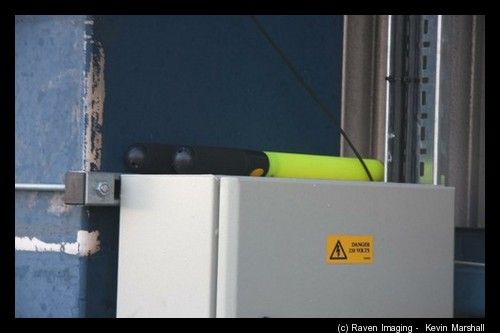
Control batons at rest.
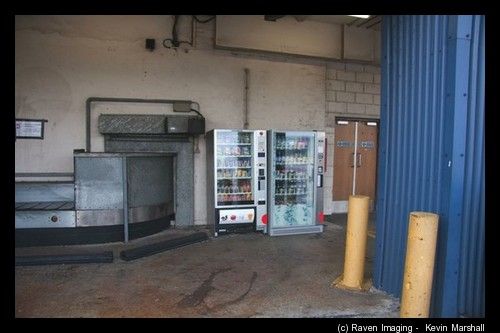
After guiding around planes, everyone needs a drink or two...
After completing the ramp walk, I was escorted back to the Operation Centre, and we were on time to meet a representative of the London City Tower team who operate for NATS.
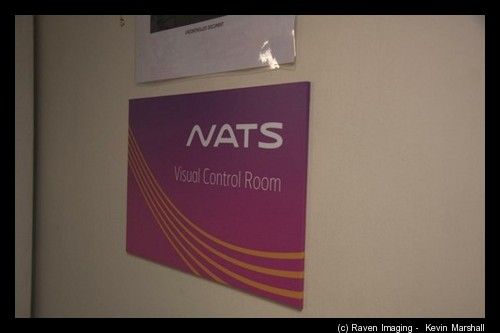
Up to the tower
We then proceeded upstairs towards an intermediate point where a safety briefing was given, as well as a list of do's and do nots. At the request of the NATS, no photography is allowed - thus the camera and all communication devices remained off for this segment.
So sorry - no pictures from the tower!
As traffic had gone down from the morning rush (where London City Airport handles over 36 movements at peak), there was a serene calm in the place as the team were working away controlling planes as they taxied, took off and landed and issuing instructions to them.
Heading up the thin spiral staircase, the first thing you see are the people working the tower, and the which has a view from the both ends of the runway, across the apron and to the edge of the JetCentre.
The explanation of the roles they did and what each of their monitors showed them, and how that related to how traffic is handled - both in the ground, at 3000ft up (where City's control height) and the relation to Heathrow Traffic (which is descending at 5000ft and above).
Citys control area is overlapped by six major fields nearby: Biggin Hill, Heathrow, Northholt, Stansted and Gatwick, with the Heathrow stacks over Lamborne (NE of Heathrow ), Biggin Hill (SE), Bovingdon, Oakham (SW) and Bovingdon (NW) - so its a very busy bit of air that the team work in.
There is of course the electronic version of the paper strip system which is interesting to see in use. The tower team at all times have two qualified controllers on the deck, allowing for an instant handover if something goes wrong. Both systems are set up the same as well so a controller can switch from system to system without any downtime.
The team have a wide variety of aircraft to handle - as well as corporate jets, they also manage the following types of aircraft
- Airbus A318
- BAe146/AvroRJ Families
- BAe 41 JetStream
- ATR42/72 (and variants)
- DHC Dash 7
- Bombardier Dash 8/Q Series
- Dornier Fairchild Do328/328 JET
- Embarer ERJ-135, E-170, E190 (SR)
- Fokker 50, Fokker 70
- Saab 340, Saab 2000
All of which have to handle the very steep approaches both in and out of the airport at a 5.5 degree or greater glide-scope (compared to the 3 degree found at many other airports). And it only becomes apparent what this glide-scope is like when watching it from a tower with 6 miles of visibility - the plane literally pops from the cloud on a steep arrival.
It's a massive responsibility to keep these people safe, and the calm and professionalism of this working crew showed through as I exited what is a very rare privilege to go to a live active tower.
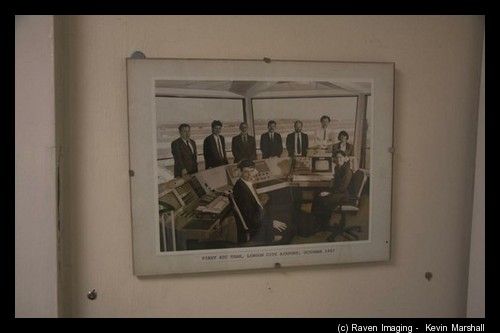
A picture of the first ATC Team at London City Airport when it opening in 1987.
#8
After visiting the tower, it was time to head over to the Fire Service at London City Airport.
At the airport they operate 4 fire vehicles (two of which must be functional to allow the airport to operate) and two boats.
Why boats I hear you ask?
London City Airport is surrounded by water - be it the Royal Albert Dock in which it resides and the River Thames that is around it - thus a Fire "boat" service is an essential part of the service that is needed.
The team of fire-fighters have a number of jobs around the airport, beyond simply those you might expect in an emergency. They operate 4 fire vehicles, of various ages. Two tenders have to be working to allow the airport to operate.
Miles from Blighty had a great experience with team putting out a fire. I was to get something different... Quite different.
After walking from the Tower and Operations toward the first fire station, the firemen check I didn't get sea sickness, there was a safety briefing... And then out on a big fire truck.
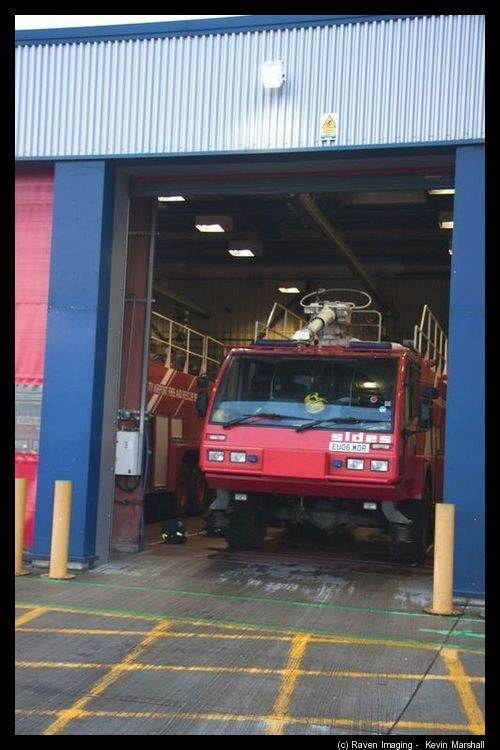
Not this Fire truck...
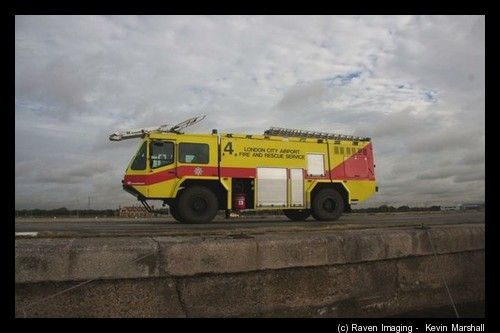
This fire truck
And you know what... I did feel like a big kid in a candy shop as I was allowed a front seat
The trick drive from from the fire station, along the ramp and along to taxi way delta, and finally onto a side road you'll see that runs parallel to the the Thames side of runway - this is Pontoon Road.
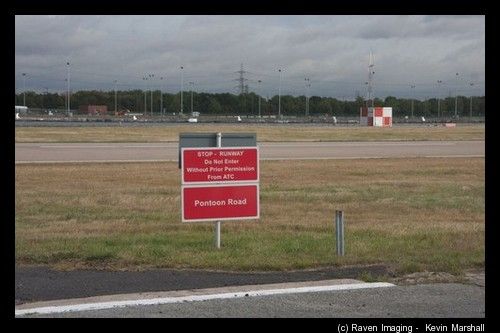
After parking up, life jackets were issued and then it was onto the rigged inflatable.
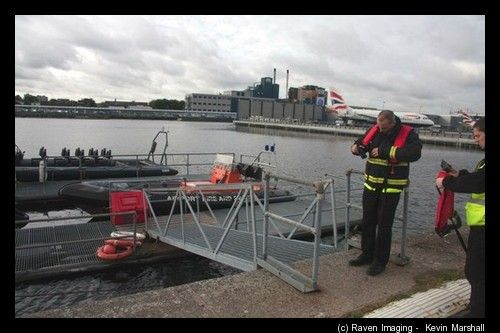
After making sure we were all aboard safely it was time to push back and power up.
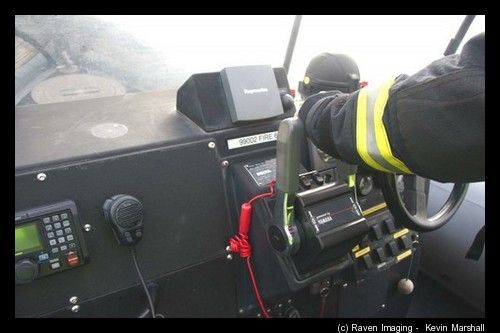
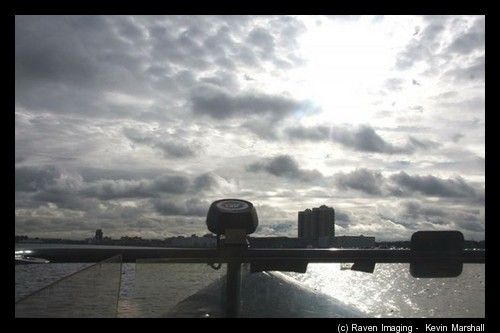
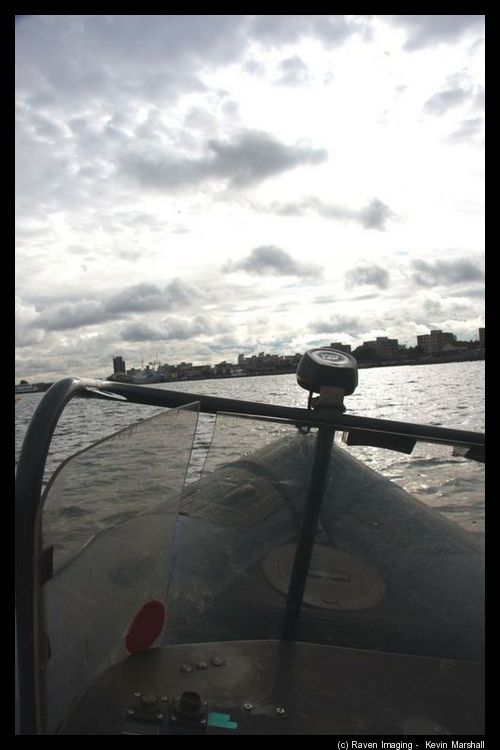

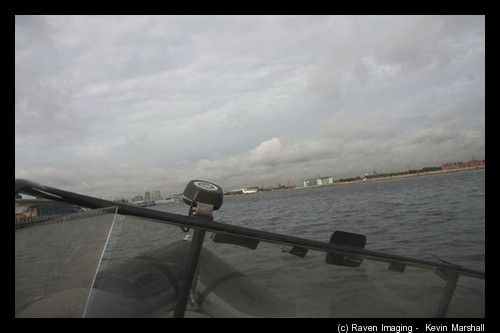
The Fire services duties are numerous - from actual fires on the ground to spillage cleanup, to hazmat containment, they also do a lot of work on the water.
Apart from training for the obvious (dread the thought - a water landing), the fire teams main duties is sadly to help out when there is a suicide attempt that sometime occur in the Additionally they help out with canoes capsizing and other water based activities that happen in the Royal Albert Dock.
Training runs from the team take them as far as west Westminster bridge, and as far east as the Dartford crossing to allow them to train for all eventualities.
From the water there are also some views that you won't see every day of the week when at London City Airport from the docks.
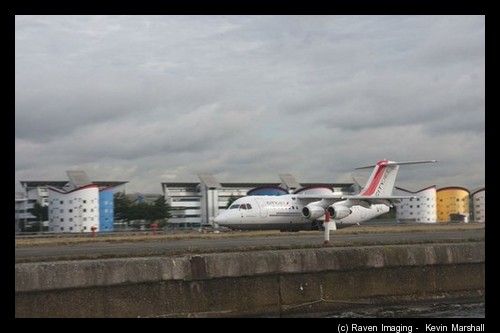
CityJet Avro on departure

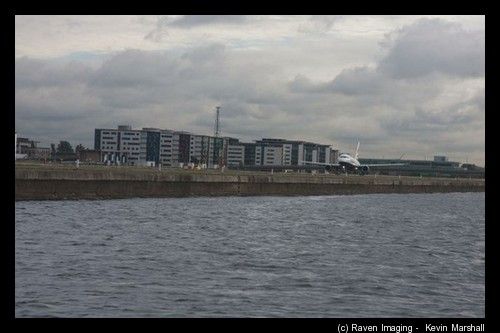
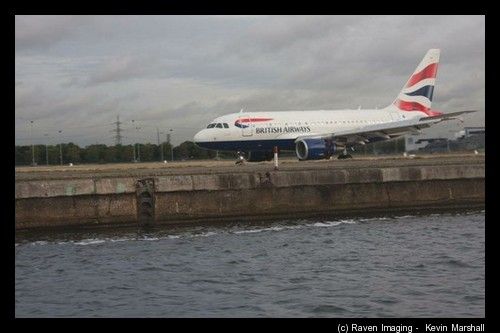
British Airways A318 (G-ENUA) arriving from New York
After a few more powerful turns, the Fire Crew docked the ridged-inflatable back at the dock and dropped us off at Gate 23 for another security check.
One of the things I took away from this trip to London City Airport is simple: There is a lot to running an airport of any size - and even the Fire service on site has a depth and richness to it that you wouldn't expect at first sight.
Or as
Miles from Blighty would put it it - a job for the brave.
At the airport they operate 4 fire vehicles (two of which must be functional to allow the airport to operate) and two boats.
Why boats I hear you ask?
London City Airport is surrounded by water - be it the Royal Albert Dock in which it resides and the River Thames that is around it - thus a Fire "boat" service is an essential part of the service that is needed.
The team of fire-fighters have a number of jobs around the airport, beyond simply those you might expect in an emergency. They operate 4 fire vehicles, of various ages. Two tenders have to be working to allow the airport to operate.
Miles from Blighty had a great experience with team putting out a fire. I was to get something different... Quite different.
After walking from the Tower and Operations toward the first fire station, the firemen check I didn't get sea sickness, there was a safety briefing... And then out on a big fire truck.

Not this Fire truck...

This fire truck
And you know what... I did feel like a big kid in a candy shop as I was allowed a front seat
The trick drive from from the fire station, along the ramp and along to taxi way delta, and finally onto a side road you'll see that runs parallel to the the Thames side of runway - this is Pontoon Road.

After parking up, life jackets were issued and then it was onto the rigged inflatable.

After making sure we were all aboard safely it was time to push back and power up.





The Fire services duties are numerous - from actual fires on the ground to spillage cleanup, to hazmat containment, they also do a lot of work on the water.
Apart from training for the obvious (dread the thought - a water landing), the fire teams main duties is sadly to help out when there is a suicide attempt that sometime occur in the Additionally they help out with canoes capsizing and other water based activities that happen in the Royal Albert Dock.
Training runs from the team take them as far as west Westminster bridge, and as far east as the Dartford crossing to allow them to train for all eventualities.
From the water there are also some views that you won't see every day of the week when at London City Airport from the docks.

CityJet Avro on departure



British Airways A318 (G-ENUA) arriving from New York
After a few more powerful turns, the Fire Crew docked the ridged-inflatable back at the dock and dropped us off at Gate 23 for another security check.
One of the things I took away from this trip to London City Airport is simple: There is a lot to running an airport of any size - and even the Fire service on site has a depth and richness to it that you wouldn't expect at first sight.
Or as
Miles from Blighty would put it it - a job for the brave.
#9
The fire service tender drove over to Gate 23 where security was waiting for us. After being re-cleared, I caught a few pictures of the BA A318's parked next to each other.
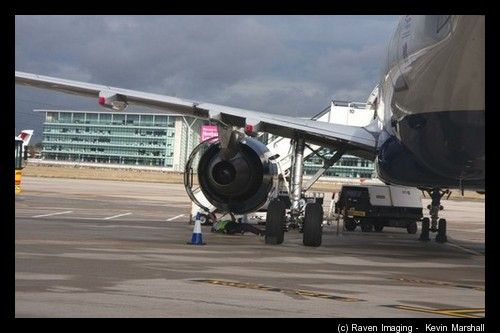
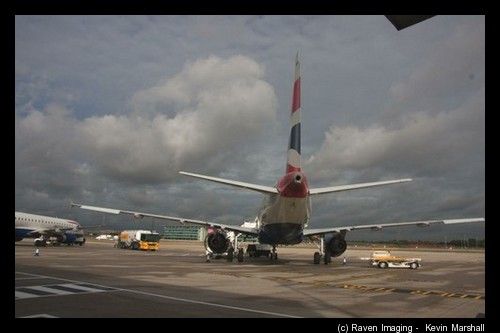
Engine work on G-EUNA
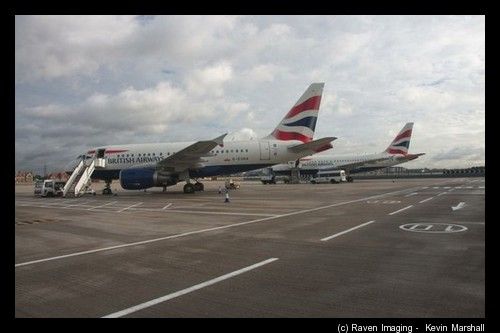
After that is was the short walk to Domestic Arrivals and the information desk where this tour started to end this tour.
I thanked my guides profusely for the tour of the airport and for the opportunities that were offered during the day.
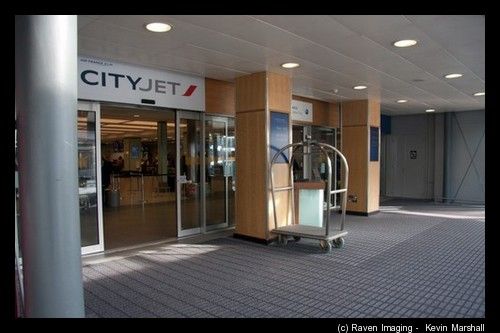
Passing the main entrance - not the BA1/3 Check-in area and trolley.

Exit to the car park and buses
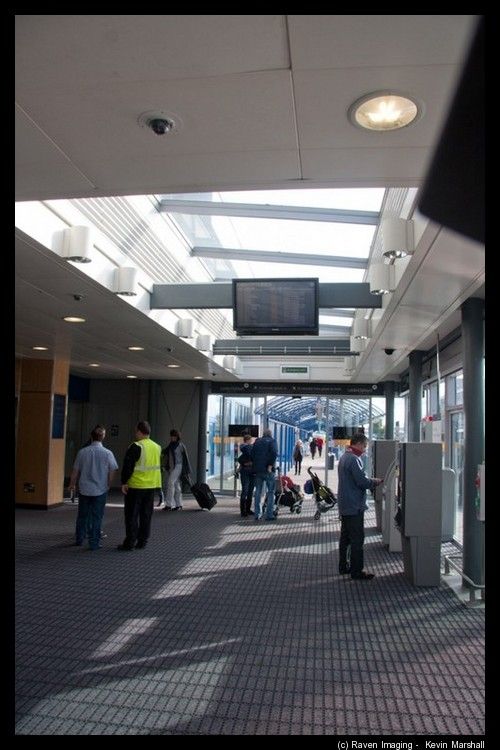
Another view
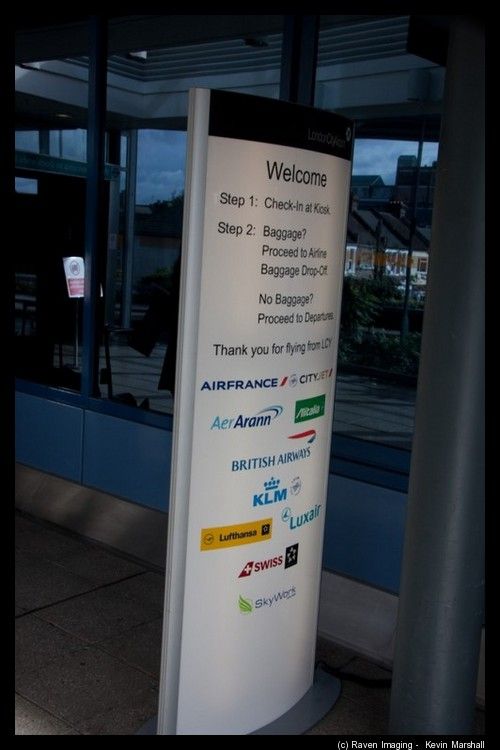
Information totem - also lists the airlines active at LCY
Armed with an information pack and a lot to digest and write about, it was time to head the short distance to the DLR station (exit the foyer, turn right to the DLR, beep an Oyster Card and then up to the platform).
Two trains later, I was back at ExCeL and at the aLoft to recombine my baggage (and also to do an emergency patch job to my clothes - no, don't ask...).
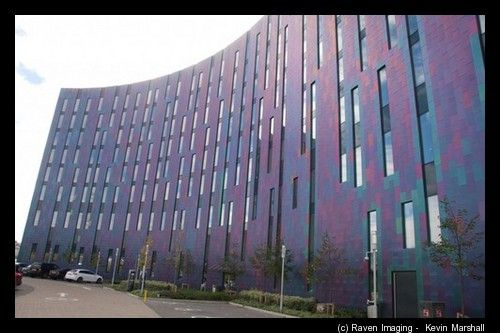
The back of the The aLoft ExCeL.
At Midday I checked out of the hotel, with all charges settled correctly. It was then off to Canary Wharf for a coffee with a friend, and then back on the Jubilee line up to Baker Street.
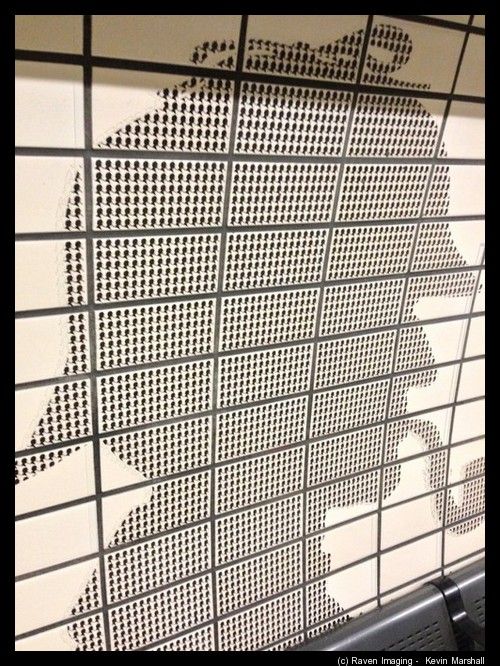
Call me soft - but I do like this bit of Tube Artwork
Then one stop across to London Marylebone main line station
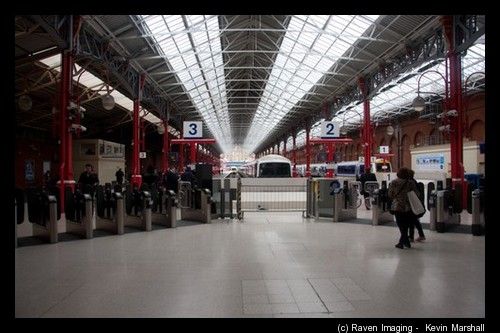
There was only a short wait for a train, and it was back to Birmingham Moor Street. Again the service was nice and fast, comfortable and not overloaded for what is an off peak journey. 1 hour 40 I was at Moor Street, and at the front door of the flat 20 minutes later.
And no red door picture for HIDDY. I was more interested in heading back out to the shop to get some food for the evening.
-----
And that's a peak behind the scenes at London City Airport.
The impression I got of the airport and its staff is professionalism, care to the job and a sense it was a big family as opposed to larger faceless places - something that carries through when it comes to customer interaction
The Marketing and Press Team who were my hosts that day do an excellent job with a well filled Twitter feed that is manned by a person, and keeping people informed - which is so important in a place where people are moving in and out and need to know what is going on.
They also have one hell of a Internet connectivity link at London City Airport if you're going through and using their Free WiFi - to deal with the surges in use, they have upgraded from 10mb line to a 100mb line so that users can keep connected at speed.
For an airport that targets business travellers - the need for decent connectivity on the road is met here - something that is lacking at even major hubs.
London City Airport has various factors going for it - least of all its location, but its people, its service, and its "can do" attitude. Combine that with the detail to safety, the growing route network and the connectivity to and from the airport as well as the speed you can get through the place...
If your travels take you through to London and London City Airport comes up as an end point to your journey, I'd urge you to try it.
You might be very surprised as it puts some of the pleasure back into flying.
I'd like add my personal thanks the Marketing and Communications Team at London City Airport for hosting me for the day and to the management at Boarding Area for passing me over the invitation for the rare behind the scenes visit of London City Airport.
Your thoughts and comments are welcome as always
Disclosure: London City Airport kindly supplied a hotel room at aLoft ExCeL to me to assist in this visit. Some details and factual information has been provided by London City Airport Corporate Communications Department.
All opinions expressed within this trip are my own, represent my own personal thoughts and my observations during the visit.
My Previous Trip Reports
LHR-BRU-LHR ... or "How do you burn a �50 BMI voucher without too much pain?"
MAN-ORD on BMI (29/10 ... or Did Kevin Make it to ORD?)
Kevin goes for a little mileage run on UA - ORD/CHM/IAD/EWR/ORD
ORD-MAN in BMI Premium Economy (with Pictures)
Kevin’s American Adventure – MAN-ORD-SEA-ORD-MAN (4 flights, 2 weeks) in Y..
ORD - MAN in BMI Premium Economy: How hard can a PE product drop? (also random moans)
LHR-PHL-SEA, SEA-PHX-ORD, ORD-PHL-LHR - In Y, Come and be scared with US!
LHR-SFO-LHR - If you're going to San Francisco - SFO MegaDO Trip report
Gold Run - Mr Kevincm goes to Washington with EI and US
Long Haul Commuter Run - LHR-IAD-ORD and back with UA
Saying Goodbye to a Friend - Travelling for the wrong reasons - LHR-PHL with UA (Also on GhettoIFE.com - expanded)
The BA Y+/Y Class Long Haul Experience LHR-BKK/SIN-SYD and back on a bargain fare (Also on GhettoIFE.com -Expanded)
The Autumn Run - Mixing Business with Pleasure (C/F/Y adventures with UA and US) (Also on GhettoIFE.com -Expanded)
Long Way Home - The Spring Commute with UA and CO (Also on GhettoIFE.com - Expanded)
Atlanta or Bust (and Frankfurt too!) - (Also on GhettoIFE.com - Expanded)
Drinks in Belfast with the BMI Board with LCC’s - (Also on GhettoIFE.com - Expanded)
Kevin get’s a bit of Seoul - First and Business class with Asiana Airlines and Thai to Seoul and Hong Kong (Also on GhettoIFE.com - Expanded)
Mixed Classes and Infinite/Madness: The Autumn Run with United - LHR-ORD-LAS-LAX-SFO-DEN-LHR - Also on GhettoIFE.com - expanded
Gold Run 2: Blame Canada! It's Only A Mileage Run anyway! (To YVR with AC, CO, BD..) also on Also on GhettoIFE.com - expanded
Re-Creating a Photo - To New York with United, British Airways and BMI Baby (Also on GhettoIFE.com)
Going the Canadian Way: To Chicago with Air Canada (LHR-YYZ-ORD in Y) (also on GhettoIFE.com)
SEN for �129? SEN Status Match Run with Swiss and Helvetic. (also on GhettoIFE.com)
Multimodal Mayhem with Coaches, Ferries, Brussels Airlines and Air Canada (also on GhettoIFE.com)
A Smooch of Chicago and a Kiss of DC – with United – LHR-ORD-IAD-LHR (also on GhettoIFE.com)
Narrow Minds and Narrow Bodies - To Denver with the New United, Aer Lingus and FlyBe (also on GhettoIFE.com)
Farewell Miles to Japan, Hong Kong and Seoul with ANA, Thai and Asiana with ANA's new 787 (also on GhettoIFE.com)
Creating a Photo - to New York with British Airways aboard the Airbus A318 in Club World London City (also on GhettoIFE.com)


Engine work on G-EUNA

After that is was the short walk to Domestic Arrivals and the information desk where this tour started to end this tour.
I thanked my guides profusely for the tour of the airport and for the opportunities that were offered during the day.

Passing the main entrance - not the BA1/3 Check-in area and trolley.

Exit to the car park and buses

Another view

Information totem - also lists the airlines active at LCY
Armed with an information pack and a lot to digest and write about, it was time to head the short distance to the DLR station (exit the foyer, turn right to the DLR, beep an Oyster Card and then up to the platform).
Two trains later, I was back at ExCeL and at the aLoft to recombine my baggage (and also to do an emergency patch job to my clothes - no, don't ask...).

The back of the The aLoft ExCeL.
At Midday I checked out of the hotel, with all charges settled correctly. It was then off to Canary Wharf for a coffee with a friend, and then back on the Jubilee line up to Baker Street.

Call me soft - but I do like this bit of Tube Artwork
Then one stop across to London Marylebone main line station

There was only a short wait for a train, and it was back to Birmingham Moor Street. Again the service was nice and fast, comfortable and not overloaded for what is an off peak journey. 1 hour 40 I was at Moor Street, and at the front door of the flat 20 minutes later.
And no red door picture for HIDDY. I was more interested in heading back out to the shop to get some food for the evening.
-----
And that's a peak behind the scenes at London City Airport.
The impression I got of the airport and its staff is professionalism, care to the job and a sense it was a big family as opposed to larger faceless places - something that carries through when it comes to customer interaction
The Marketing and Press Team who were my hosts that day do an excellent job with a well filled Twitter feed that is manned by a person, and keeping people informed - which is so important in a place where people are moving in and out and need to know what is going on.
They also have one hell of a Internet connectivity link at London City Airport if you're going through and using their Free WiFi - to deal with the surges in use, they have upgraded from 10mb line to a 100mb line so that users can keep connected at speed.
For an airport that targets business travellers - the need for decent connectivity on the road is met here - something that is lacking at even major hubs.
London City Airport has various factors going for it - least of all its location, but its people, its service, and its "can do" attitude. Combine that with the detail to safety, the growing route network and the connectivity to and from the airport as well as the speed you can get through the place...
If your travels take you through to London and London City Airport comes up as an end point to your journey, I'd urge you to try it.
You might be very surprised as it puts some of the pleasure back into flying.
I'd like add my personal thanks the Marketing and Communications Team at London City Airport for hosting me for the day and to the management at Boarding Area for passing me over the invitation for the rare behind the scenes visit of London City Airport.
Your thoughts and comments are welcome as always

Disclosure: London City Airport kindly supplied a hotel room at aLoft ExCeL to me to assist in this visit. Some details and factual information has been provided by London City Airport Corporate Communications Department.
All opinions expressed within this trip are my own, represent my own personal thoughts and my observations during the visit.
My Previous Trip Reports
LHR-BRU-LHR ... or "How do you burn a �50 BMI voucher without too much pain?"
MAN-ORD on BMI (29/10 ... or Did Kevin Make it to ORD?)
Kevin goes for a little mileage run on UA - ORD/CHM/IAD/EWR/ORD
ORD-MAN in BMI Premium Economy (with Pictures)
Kevin’s American Adventure – MAN-ORD-SEA-ORD-MAN (4 flights, 2 weeks) in Y..
ORD - MAN in BMI Premium Economy: How hard can a PE product drop? (also random moans)
LHR-PHL-SEA, SEA-PHX-ORD, ORD-PHL-LHR - In Y, Come and be scared with US!
LHR-SFO-LHR - If you're going to San Francisco - SFO MegaDO Trip report
Gold Run - Mr Kevincm goes to Washington with EI and US
Long Haul Commuter Run - LHR-IAD-ORD and back with UA
Saying Goodbye to a Friend - Travelling for the wrong reasons - LHR-PHL with UA (Also on GhettoIFE.com - expanded)
The BA Y+/Y Class Long Haul Experience LHR-BKK/SIN-SYD and back on a bargain fare (Also on GhettoIFE.com -Expanded)
The Autumn Run - Mixing Business with Pleasure (C/F/Y adventures with UA and US) (Also on GhettoIFE.com -Expanded)
Long Way Home - The Spring Commute with UA and CO (Also on GhettoIFE.com - Expanded)
Atlanta or Bust (and Frankfurt too!) - (Also on GhettoIFE.com - Expanded)
Drinks in Belfast with the BMI Board with LCC’s - (Also on GhettoIFE.com - Expanded)
Kevin get’s a bit of Seoul - First and Business class with Asiana Airlines and Thai to Seoul and Hong Kong (Also on GhettoIFE.com - Expanded)
Mixed Classes and Infinite/Madness: The Autumn Run with United - LHR-ORD-LAS-LAX-SFO-DEN-LHR - Also on GhettoIFE.com - expanded
Gold Run 2: Blame Canada! It's Only A Mileage Run anyway! (To YVR with AC, CO, BD..) also on Also on GhettoIFE.com - expanded
Re-Creating a Photo - To New York with United, British Airways and BMI Baby (Also on GhettoIFE.com)
Going the Canadian Way: To Chicago with Air Canada (LHR-YYZ-ORD in Y) (also on GhettoIFE.com)
SEN for �129? SEN Status Match Run with Swiss and Helvetic. (also on GhettoIFE.com)
Multimodal Mayhem with Coaches, Ferries, Brussels Airlines and Air Canada (also on GhettoIFE.com)
A Smooch of Chicago and a Kiss of DC – with United – LHR-ORD-IAD-LHR (also on GhettoIFE.com)
Narrow Minds and Narrow Bodies - To Denver with the New United, Aer Lingus and FlyBe (also on GhettoIFE.com)
Farewell Miles to Japan, Hong Kong and Seoul with ANA, Thai and Asiana with ANA's new 787 (also on GhettoIFE.com)
Creating a Photo - to New York with British Airways aboard the Airbus A318 in Club World London City (also on GhettoIFE.com)
#11
Fascinating report! We flew into LCY for the first time a couple of weeks ago so it was very interesting to see "behind the scenes". Thanks for posting.
#14
Love reading this "Not a typical FT trip report".
You should diversify to become a photojournalism reporter in addition to your other photo talents.
Great read and provided me a different perspective on air travel!
You should diversify to become a photojournalism reporter in addition to your other photo talents.
Great read and provided me a different perspective on air travel!
#15
Quote:
No problem. Glad you enjoyed WiirachayOriginally Posted by Wiirachay
Interesting! A unique viewpoint. Thanks for sharing.
Quote:
Hope you enjoyed flying into LCY - the short runway gets me every time when landing there. Glad you enjoyed the "Behind the scenes" Originally Posted by SFO777
Fascinating report! We flew into LCY for the first time a couple of weeks ago so it was very interesting to see "behind the scenes". Thanks for posting.
 SFO777
SFO777Quote:
I love LCY and it was nice to gain an insight into its operations.
Glad you liked nizolidas. Its only when you get to go beyond what you see on the surface do you get a glimps of what goes on the tarmac, the ramp and beyond. Originally Posted by nizolidas
Thanks for sharing the experience!! Very interesting and informative report.I love LCY and it was nice to gain an insight into its operations.

Quote:
Not a problem amolkold Originally Posted by amolkold
Cool! Thanks for the great writeup.

Quote:
You should diversify to become a photojournalism reporter in addition to your other photo talents.
Great read and provided me a different perspective on air travel!
Thanks UA_Flyer. I was honoured that I was invited over so I could spend some time taking pictures, asking questions and learning about what makes an airport work.Originally Posted by UA_Flyer
Love reading this "Not a typical FT trip report". You should diversify to become a photojournalism reporter in addition to your other photo talents.
Great read and provided me a different perspective on air travel!
I did publish this on the blog, but I always try and give back.
Who knows - with the industry I work in going to the place it is... maybe it is time to branch out - certainly, this has given me the chance to go places that very few have access to.
Glad you enjoyed UA_Flyer.


















